Book of Revelations
Tamerlane
Emperor Flavius
Oracle of Delphi
the Goths
Caesar Augustus
Alexander the Great
Pline the Elder
Athens / Sparta
Queen of the Amazons
the Virgin Mary's House
St John
St Paul
Seven Wonders of the World
Ephesus
We had been told that if we ever wanted to see the finest Roman ruins in the world, we should go not to Rome, but to Turkey. Those ruins were to be found in the city of Ephesus. I'll give the overview provided by Wikipedia and other sources, but the reason the city remains so pristine is that, unlike so many other ancient cities, Ephesus was abandoned. It was abandoned because, even though it was the second largest city in their world, it depended upon its harbor. The river beside Ephesus, which fed the harbor, silted the harbor completely. Today, the Ephesus harbor is 5 kilometers inland. The loss of its harbor caused Ephesus to lose its access to the Aegean Sea.
Although the city had a long history of being destroyed and rebuilt, the Roman era saw the end of the city as a center of commerce, and the city was, for all practical purposes, abandoned. Consequently, the city was not built upon, layer by layer as time went by as was, for example, Troy with its 12 layers. Even old Rome, the Senate and other buildings were completely underground until Mussolini had the covering soil and ruins removed - probably the only good thing he did.
I had no idea that other than home to the largest Roman Theater in existence and the large amount of pristine ruins, or that Ephesus was associated with, in no particular order - (get this!)
|
Book of Revelations | |
|
Tamerlane | |
|
Emperor Flavius | |
|
Oracle of Delphi | |
|
the Goths | |
|
Caesar Augustus | |
|
Alexander the Great | |
|
Pline the Elder | |
|
Athens / Sparta | |
|
Queen of the Amazons | |
|
the Virgin Mary's House | |
|
St John | |
|
St Paul | |
|
Seven Wonders of the World |
AND this is just a few. A person could spend months reading only about Ephesus, and weeks walking the area - how in the world could we, in a day, ever hope to even get an overview?
This page was the most frustrating of any I've ever done. The wealth of history and the number of important sections of Ephesus was staggering. I would review and edit the pictures, do a bit of research and documentation, and then organize the page. Each time the research would indicate even more information and a review of the pictures would cause me to do ore research - a nasty loop without an apparent end. I almost just stopped and was ready to release the page as is, refusing to be further caught up in the review, research, review cycle again - but I felt I had to see it through.
Consequently, you will find more documentation than pictures I'm afraid. Again, more thanks to Wikipedia, the free encyclopedia than I'll ever be able to express.
~ ~ ~ ~ ~ ~ ~ ~ ~ ~ ~ ~ ~ ~ ~ ~ ~ ~ ~ ~ ~ ~ ~ ~ ~ ~ ~
Ephesus (Ancient Greek Ἔφεσος, Turkish Efes) was an ancient Greek city, and later a major Roman city, on the west coast of Asia Minor. It was one of the twelve cities of the Ionian League during the Classical Greek era. In the Roman period, it was for many years the second largest city of the Roman Empire; ranking behind Rome, the empire's capital. Ephesus had a population of more than 250,000 in the 1st century BC, which also made it the second largest city in the world.
The city was famed for the Temple of Artemis (completed around 550 BC), one of the Seven Wonder of the world. The temple was destroyed in 401 AD by a mob led by St. John. Emperor Constantine I rebuilt much of the city and erected new public baths. The town was again partially destroyed by an earthquake in 614 AD. The city's importance as a commercial center declined as the harbor was slowly silted up by the Cayster (Küçük Menderes).
Ephesus was one of the seven churches of Asia that are cited in the Book of Revelation . In Revelation Chapter two they were commended by Jesus for their labor to the point of exhaustion, their perseverance and their unwillingness to listen to the false teachers of their day. Jesus does hold one thing against them..."you have left your first love." Their Christianity had become a faithful ritual but not a relationship of love to the Lord. The Gospel of John may have been written here. It is also the site of a large gladiator's graveyard.
The area surrounding Ephesus was already inhabited during the Neolithic Age (about 6000 BC), as was revealed by the excavations at the nearby hoyuk (artificial mounds known as tells) of Arvalya and Cukurici
Excavations in recent years have unearthed settlements from the early Bronze Age at the Ayasuluk Hill. In 1954 a burial ground from the Mycenaean era (1500-1400 BC) with ceramic pots was discovered close to the ruins of the basilica of St. John. This was the period of the Mycenaean Expansion when the Achaioi (as they were called by Homer)
Ephesus was founded as an Attic-Ionian colony in the 10th century BC on the Ayasuluk Hill, three kilometers from the center of antique Ephesus The mythical founder of the city was a prince of Athens named Androklos, who had to leave his country after the death of his father, King Kadros. According to the legend, he founded Ephesus on the place where the oracle of Delphii became reality ("A fish and a boar will show you the way"). Later, Greek historians such as Pausanias, Strato, the poet Kallinos, and the historian Herodotos reassigned the city's mythological foundation to Ephos, queen of the Amazons.
During the Peloponnesian War, Ephesus was first allied to Athens but sided in a later phase, called the Decelean War, or the Ionian War, with Sparta, which also had received the support of the Persians. As a result, rule over the cities of Ionia was ceded again to Persia.
These wars did not much affect daily life in Ephesus. The Ephesians were surprisingly modern in their social relations. They allowed strangers to integrate. Education was much valued. Through the cult of Artemis, the city also became a bastion of women's rights. Ephesus even had female artists. In later times, Pliny the Elder mentioned having seen at Ephesus a representation of the goddess Diana by Timarata, the daughter of a painter.
When Alexander the Great defeated the Persian forces at the Battle of Granicus in 334 BC, the Greek cities of Asia Minor were liberated. The pro-Persian tyrant Syrpax and his family were stoned to death, and Alexander was greeted warmly when he entered Ephesus in triumph. When Alexander saw that the temple of Artemis was not yet finished, he proposed to finance it and have his name inscribed on the front. But the inhabitants of Ephesus demurred, claiming that it was not fitting for one god to build a temple to another.
Thus Ephesus became part of the Seleucid Empire. After the murder of king Antiochus II Theos and his Egyptian wife, pharaoh Ptolemy III invaded the Seleucid Empire and the Egyptian fleet swept the coast of Asia Minor. Ephesus came under Egyptian rule between 263-197 BC.
Ephesus became subject of the Roman Republic. The city felt at once the Roman influence. Taxes rose considerably, and the treasures of the city were systematically plundered. In 88 BC Ephesus welcomed Archelaus, a general of Mithridates the Great, king of Pontis, when he conquered Asia (the Roman name for western Asia Minor). This led to the Asiatic Vespers, the slaughter of 80,000 Roman citizens in Asia, or any person who spoke with a Latin accent. Many had lived in Ephesus
When Agustus became emperor in 27 BC, he made Ephesus instead of Pergamum the capital of proconsular Asis, which covered western Asia Minor. Ephesus entered an era of prosperity. It became the seat of the governor, growing into a metropolis and a major center of commerce. It was second in importance and size only to Rome. Ephesus has been estimated to be in the range of 400,000 to 500,000 inhabitants in the year 100, making it the largest city in Roman Asia and of the day. Ephesus was at its peak during the first and second century AD.
The city and temple were destroyed by the Goths in 263 AD. This marked the decline of the city's splendor.
Ephesus remained the most important city of the Byzantine Empire in Asia after Constantinople in the 5th and 6th centuries. The emperor Constantine I rebuilt much of the city and erected a new public bath. In 406 John Chrysostom, archbishop of Constantinople, ordered the destruction of the Temple of Artemis. Emperor Flavius Arcadius raised the level of the street between the theatre and the harbour. The basilica of St. John was built during the reign of emperor Justinian I in the sixth century.
The town was again partially destroyed by an earthquake in 614.
The loss of its harbor caused Ephesus to lose its access to the Aegean Sea, which was important for trade. People started leaving the lowland of the city for the surrounding hills. The ruins of the temples were used as building blocks for new homes. Marble sculptures were ground to powder to make lime for plaster.
Sackings by the Arabs first in the year 654-655 by Caliph Mauwiyah I, and later in 700 and 716 hastened the decline further.
When the Seljuk Turks conquered Ephesus in 1090, it was a small village. The Byzantines resumed control in 1100 and changed the name of the town to Hagios Theologos. They kept control of the region until 1308. Crusaders passing through were surprised that there was only a small village, called Ayasalouk, where they had expected a bustling city with a large seaport. Even the temple of Artemis was completely forgotten by the local population.
The town knew again a short period of flourishing during the 14th century under these new Seljuk rulers. They added important architectural works such as the Isa Bey Mosque, caravansaries and Turkish Bathhouses (hamam).
They were incorporated as vassals into the Ottoman Empire for the first time in 1390. The Central Asian warlord Tamerlane, defeated the Ottomans in Anatolia in 1402, and the Ottoman Sultan Bayezid I died in captivity. The region was restored to the Anatolian bevliks. After a period of unrest, the region was again incorporated into the Ottoman Empire in 1425.
Ephesus was eventually completely abandoned in the 15th century and lost her former glory. Nearby Ayasuluğ was renamed Selçuk in 1914.
Ephesus was an important center for Early Christianity from the AD 50s. From AD 52-54, Paul lived in Ephesus, working with the congregation and apparently organizing missionary activity into the hinterlands. He became embroiled in a dispute with artisans, whose livelihood depended on selling the statuettes of Artemis in the Temple of Artemis (Acts 19:23–41). He wrote between 53 and 57 AD the letter 1st Corinthians from Ephesus (possibly from the "Paul tower" close to the harbour, where he was imprisoned for a short time). Later Paul wrote the Epistle to Ephesians while he was in prison in Rome (around 62 AD).
Roman Asia was associated with John, one of the chief apostles, and the Gospel of John might have been written in Ephesus, c 90-100. Ephesus was one of the seven cities addressed in Revelation (2:1–7), indicating that the church at Ephesus was strong.
Two decades later, the church at Ephesus was still important enough to be addressed by a letter written by Bishop Ignatias of Antioch to the Ephesians in the early 2nd century AD, that begins with, "Ignatius, who is also called Theophorus, to the Church which is at Ephesus, in Asia, deservedly most happy, being blessed in the greatness and fullness of God the Father, and predestinated before the beginning of time, that it should be always for an enduring and unchangeable glory" (Letter to the Ephesians). The church at Ephesus had given their support for Ignatius, who was taken to Rome for execution.
~ ~ ~ ~ ~ ~ ~ ~ ~ ~ ~ ~ ~ ~ ~ ~ ~ ~ ~ ~ ~ ~ ~ ~ ~ ~ ~
Ephesus contains the largest collection of Roman ruins in the eastern Mediterranean. Only an estimated 15% has been excavated. The ruins that are visible give some idea of the city's original splendor, and the names associated with the ruins are evocative of its former life.
~ ~ ~ ~ ~ ~ ~ ~ ~ ~ ~ ~ ~ ~ ~ ~ ~ ~ ~ ~ ~ ~ ~ ~ ~ ~ ~
Mary's House
OK, I had no idea that Mary's house was in Turkey. In fact, I'd never given any thought to where she lived out her days, other than TV stories about going to France, et al. I was completely off balance on this and had no idea what to expect. Consequently, as we bused to the site, I snapped pictures of any ruins I saw on the off-chance that was where we were bound.

And, again, caught a view of a Crusader's Castle

Saw other ruins - some quite close
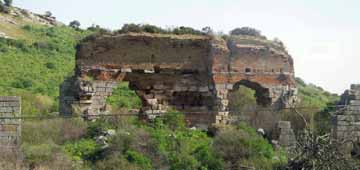
But finally, we were there. Still had no idea what to expect.

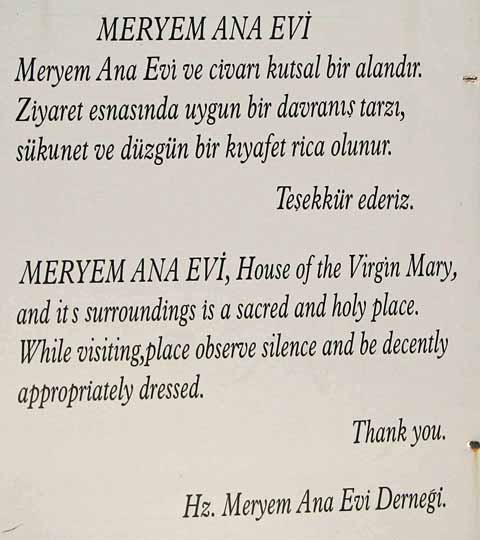
There was a service going on. I believe it had to do with a Palm Sunday service.
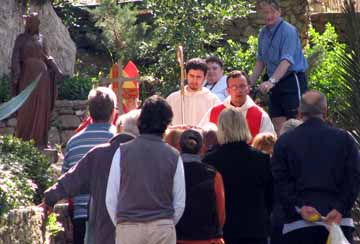
As we walked by, a Benedictine Monk passed out Olive Branches. This is because, in all probability, olive branches were passed out as Jesus passed by, not palm branches - as they were too valuable.
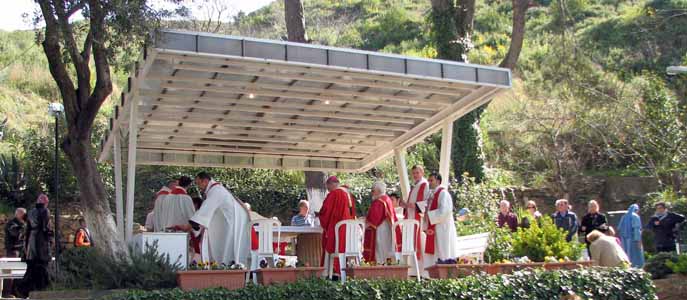
We approached the Virgin Mary's home. This outer room was built later. Her home, a smaller room, has been dated to 1 AD. There were palm branches displayed, as you see. Inside (we could not take pictures) were a variety of old objects and a barrel with crutches and canes - more on this in a few minutes....
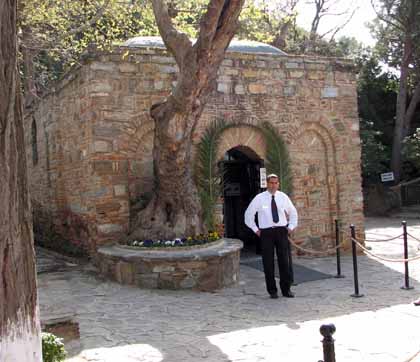

(However, I stole a picture from another website of the interior.)
Jackie stands before Mary's House. The lower section is absolutely original and dates to 1 AD.

From beneath Mary's House there flows a spring. It has been diverted to flow out a very short distance away and below the level of the home.
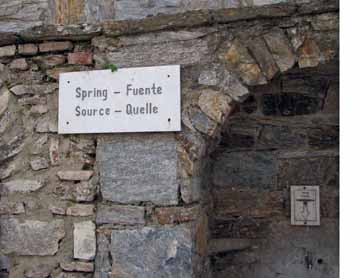
OK, again - above and beyond not expecting what we saw, I don't think anyone was prepared for the Holy Spring. It has been the source of miracles - that is where the crutches and canes in the room in front of Mary's house came from. People used the spring water and illnesses and injuries were miraculously cured.
All of us, well most of us, hustled to find something to carry water in. Many of us, Jackie and I included, grabbed our plastic water bottle, emptied them and filled them from the spring.
Upon arriving that night at our hotel, we took the bottle and the olive branch and very carefully packed them, and repacked them when we prepared to fly home. We divided the water into 12 smaller bottles and made a printout with a picture of Mary's house and the story of the spring, taped one of the leaves from the olive branch to the printout, and sent them to some Catholic (and non-Catholic) friends. They got a mix reaction, although almost everyone thanked us.
The most touching story was a close friend who was having a grand daughter baptized the next weekend. She poured her spring water from Mary's house in the baptismal font. Pretty neat!
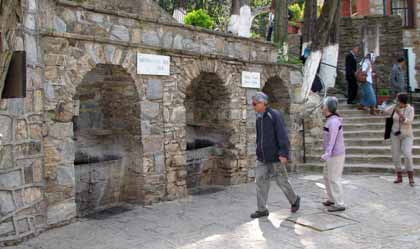
Beyond the spring was a set of bulletin type boards with chicken wire covering them. Into the chicken wire were literally thousands of prayers written by visitors.
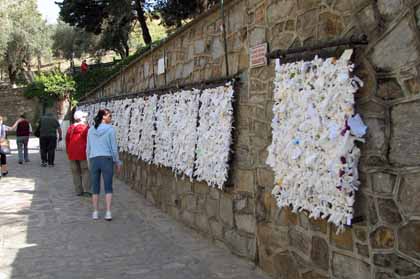
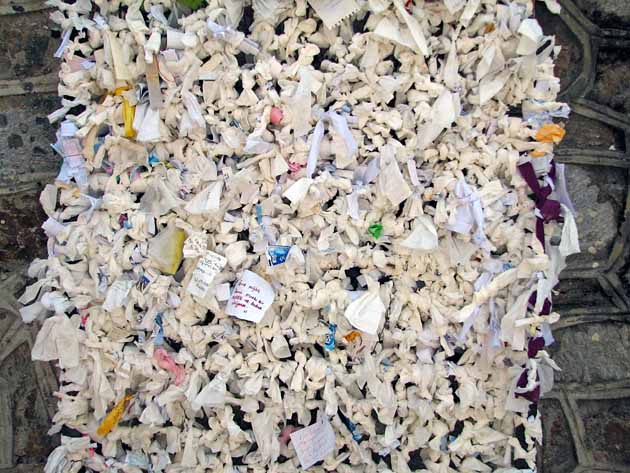
On the path to Mary's house was this excavation. We understood there were buildings on this hill top hundreds of years prior to Mary's house.
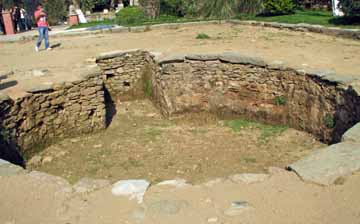
There was a wall that followed the ridge line the entire length of the mountain - received no explanation for it that I recall - but obviously very, very old.
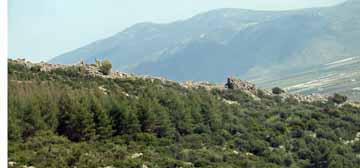
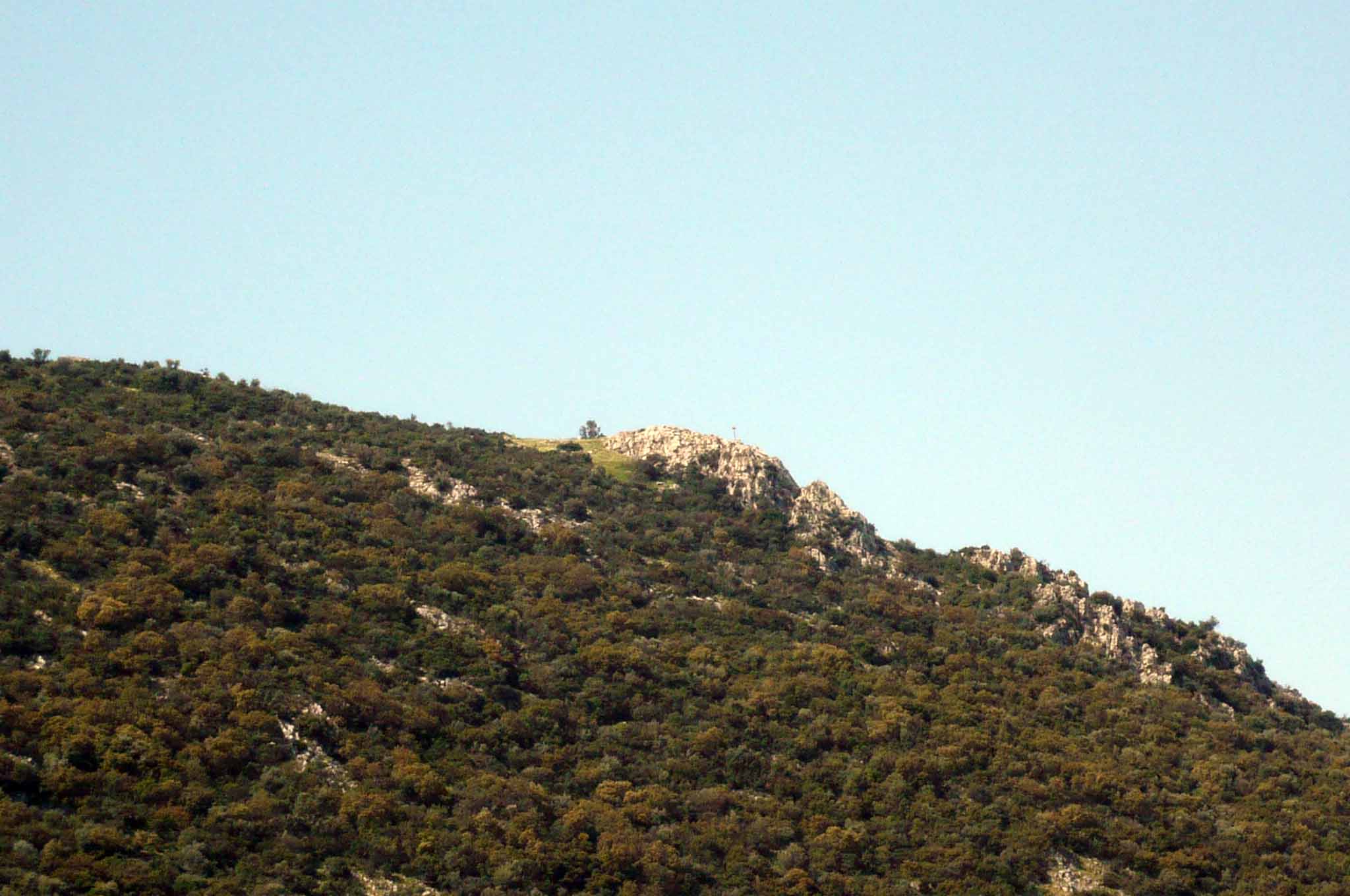
The Hellenistic city wall, erected under King Lysimachus and at least 9 kilometers long, was built in 3C BC. Today more than 3 kilometers of it is extremely well preserved on the Bulbuldag and can be seen on the way to the House of Mother Mary.
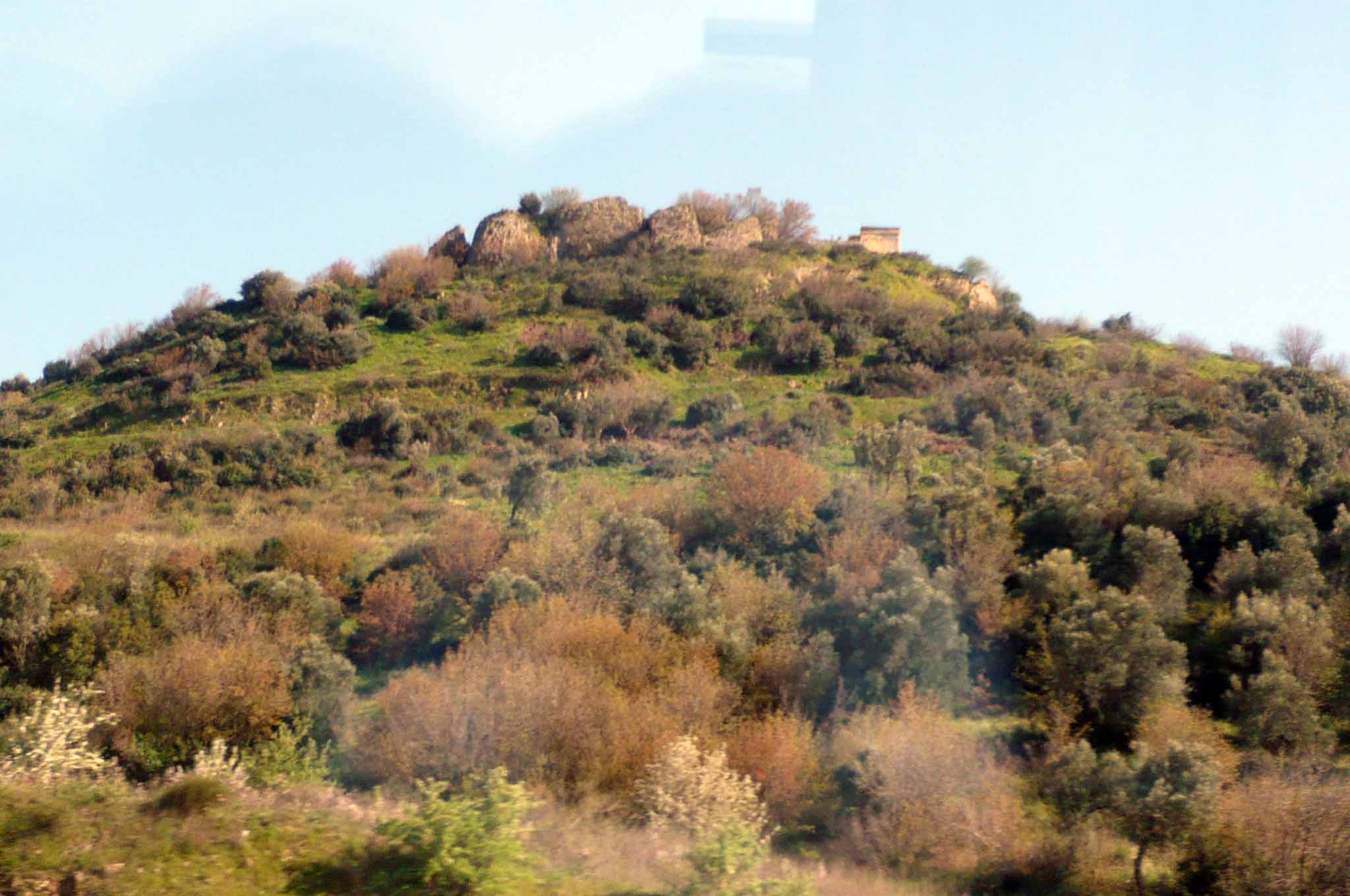
View from the hill as we bus down
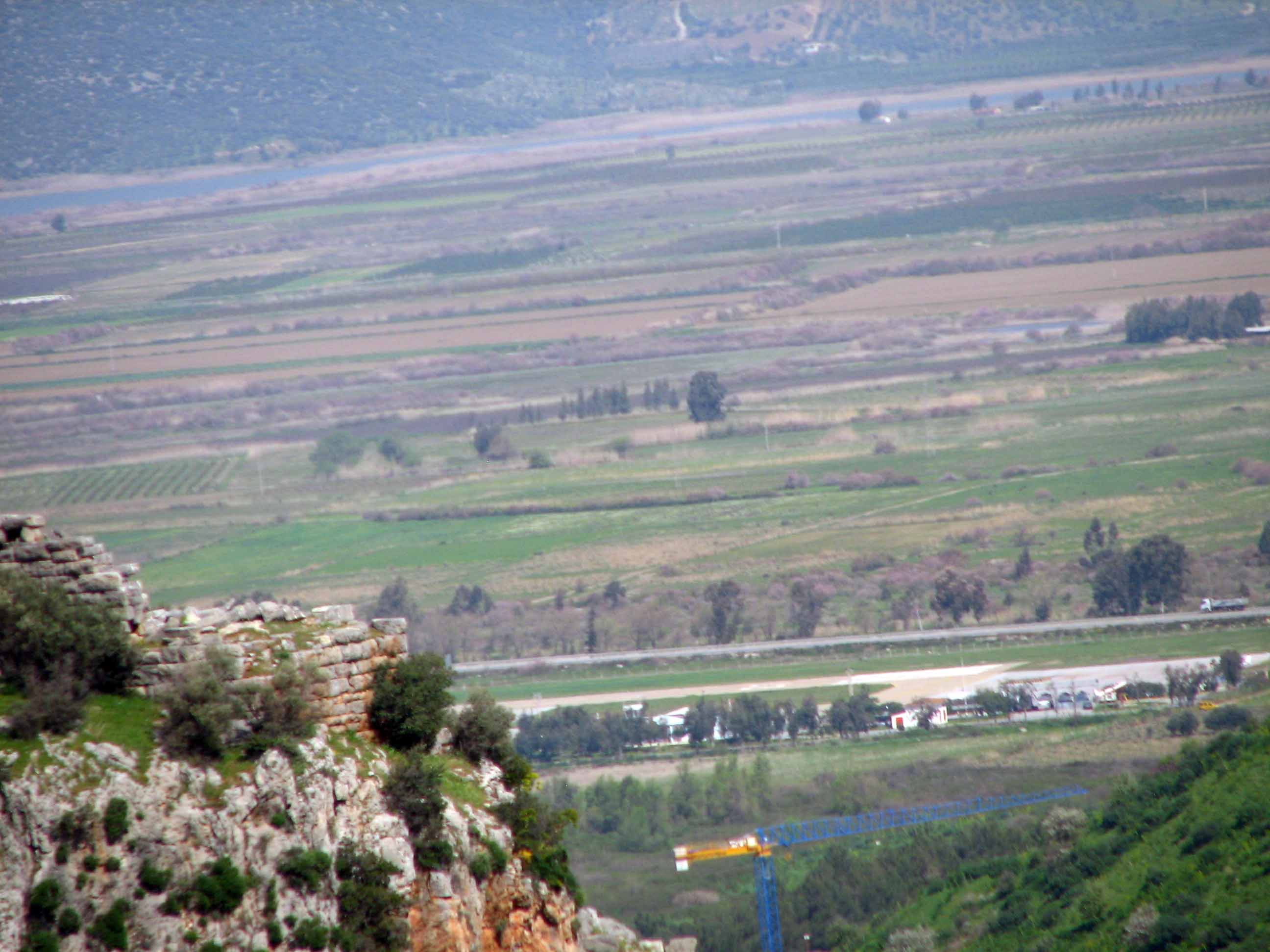
In the distance, the Crusader Castle - not knowing that below it was above Ephesus and that we would be there later in the afternoon.

As we hit the flat, returning from Mary's house, we see the statue of the Virgin Mary. Didn't get a really good picture from the bus, although we tried several times. Our guide told us this is the largest stature of the Virgin Mary in the world.
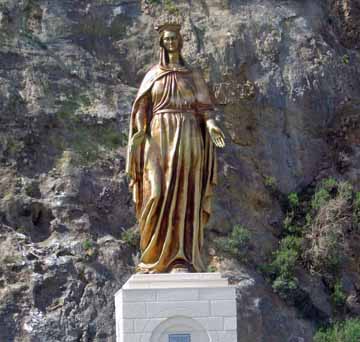

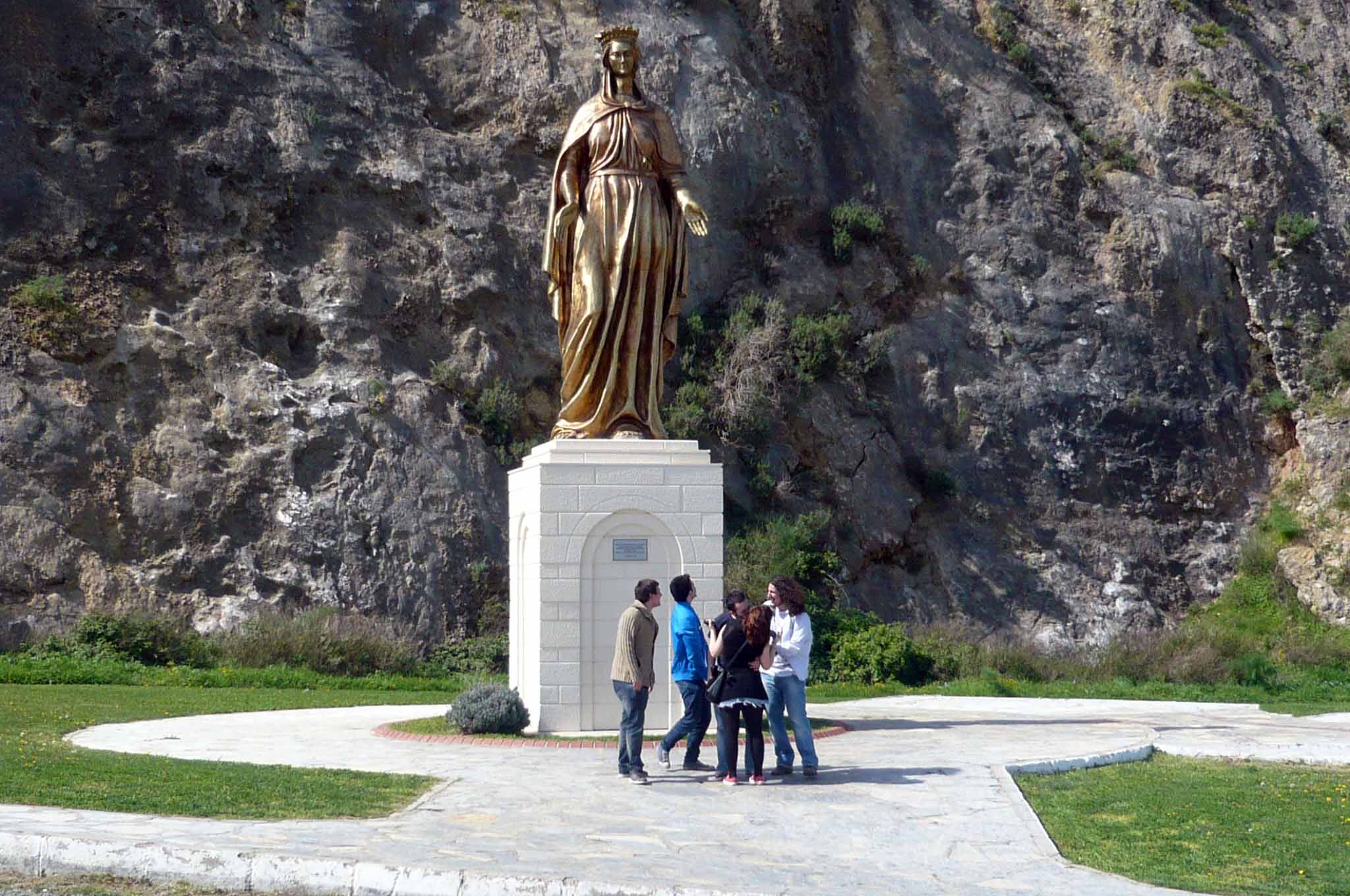
~ ~ ~ ~ ~ ~ ~ ~ ~ ~ ~ ~ ~ ~ ~ ~ ~ ~ ~ ~ ~ ~ ~ ~ ~ ~ ~ ~ ~ ~ ~ ~ ~ ~
We approach Ephesus, or EFES in Turkish


The agora on the southern part of the Basilica is the State Agora, and was built in the Roman Period in the first century B.C. This agora was used not for commerce but for business, it played an important role as a meeting place for the governmental discussions. During the excavations in the northeast corner of the Agora were found a great number of graves from the 7th-6th centuries B.C and a stone-paved road, and a archaic sarcophagus of terra cotta.
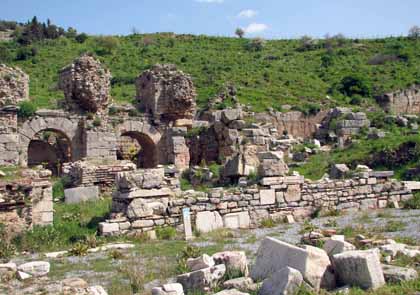

The ruins to
the east of the Basilica belong to the bath of Varius, dating to the Roman
period. The construction dates to the 2nd century A.D and the mosaics in the
40 meters long corridor dates to the 5th century. It
is built of cut blocks of marble. It has three sections, frigidarium (cold
water), tepidarium (warm water) and caldarium (hot water). The excavations
have not been completed yet.
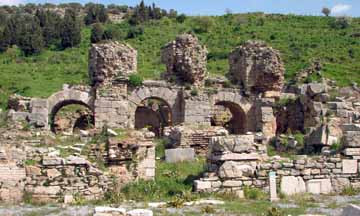
As you will see, I am fascinated by inscriptions, I guess my wonder is based upon the age of the inscriptions, often their obvious importance the and now, the few words / names I do recognize, and the mystery of an unknown / unlearned language. This below appears to be rather informal, probably a form of graffiti.
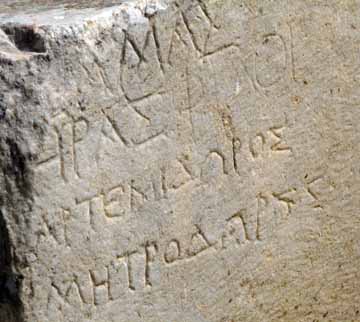
As we walked into Ephesus we passed a fig tree. Couldn't help myself and had to have pictures.
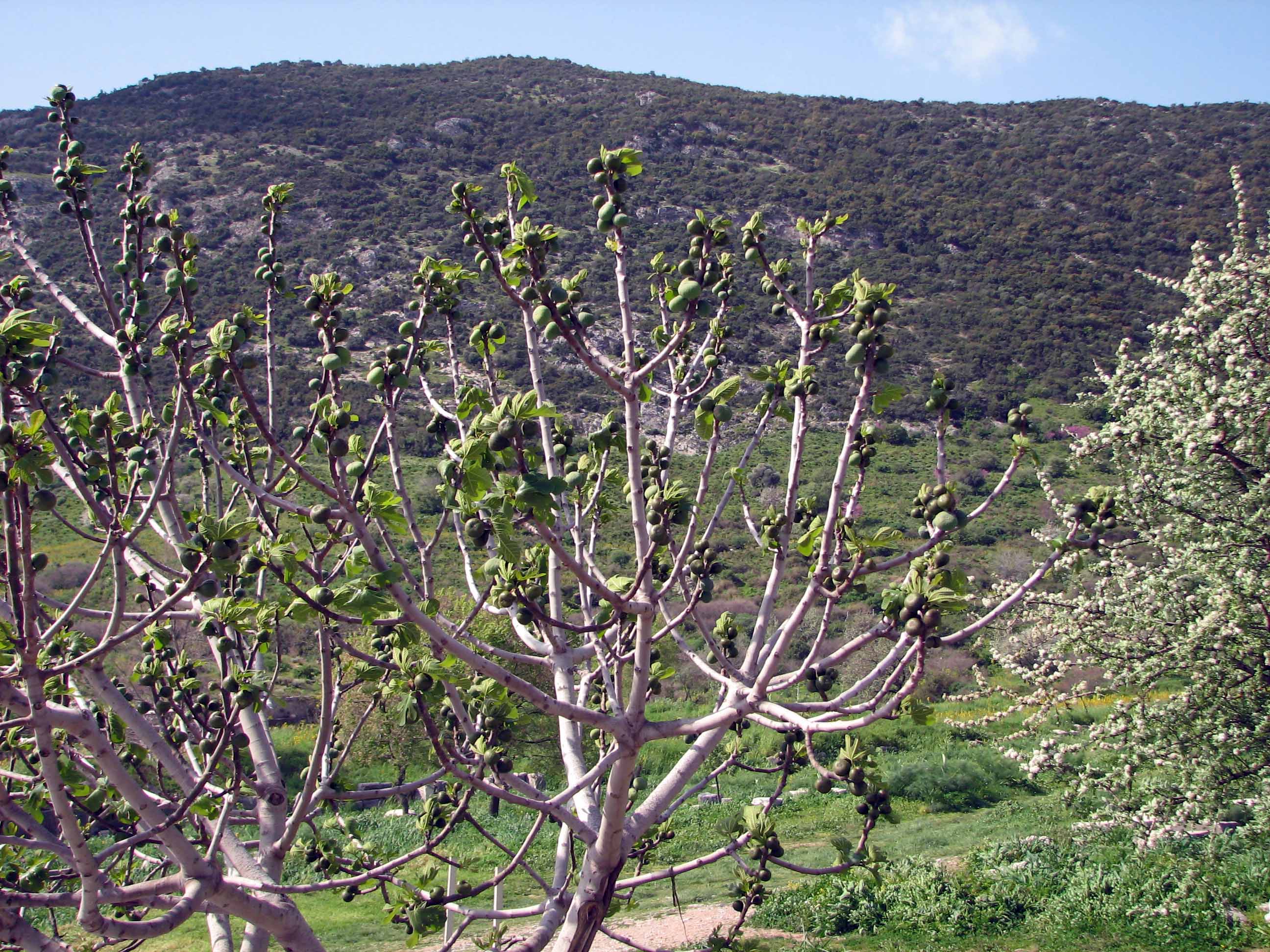

Some of the collection of items set aside from excavation
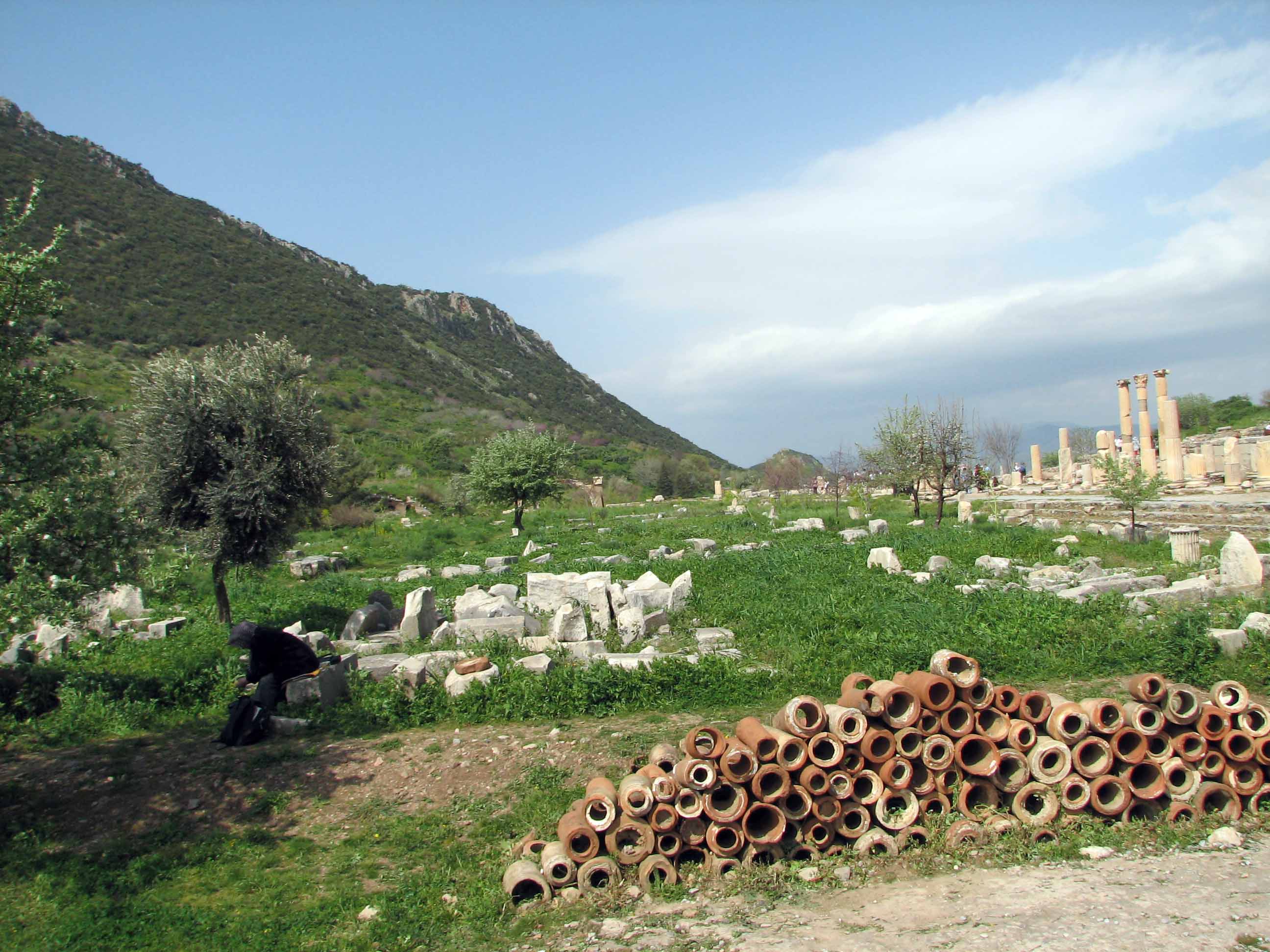
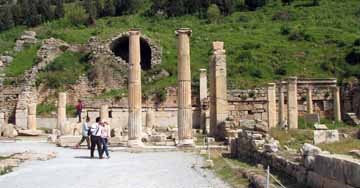
Columns and ruins on one side, while sheep grazed above us on
the hill side. 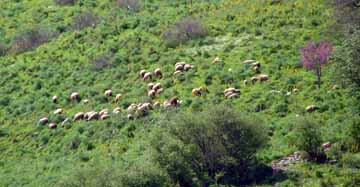
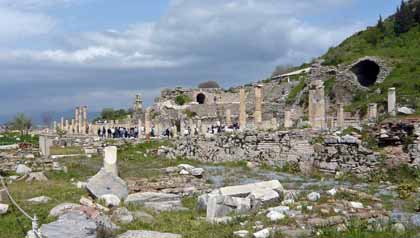
On the marble lining the street, much like wide, flat curbs, I had heard that one could find graffiti carved into them. In this case, and later you will see, game boards carved into the curbs.

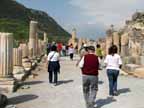
It is a typical Roman Basilica. It is 160 meters long, and located on the northern part of the state agora and has a nave and three-aisles. The Ionic columns in the basilica are adorned with bulls' head figures dating to the 1st century A.D.
The basilica was used for stock exchange and commercial business. Meetings of the law courts were also held there in the basilica. It has three gates opening onto a stoa leading to the Bath of Varius.

Ephesus was originally built on build on a hill. At the top of this hill are some of the oldest portions of the city. Most of this area is inaccessible to tourists.
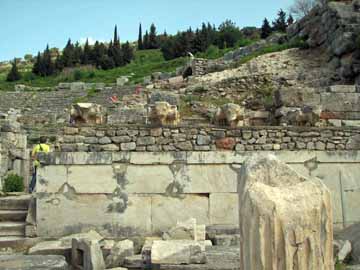
It seems wherever you look, there are columns, as along this basilica

It is one of the three main streets of Ephesus between The Hercules Gate till to the Celsus Library.This street took its name from the priests who were called as Curetes later.Their names were written in Prytaneion.
There were fountains, monuments, statues and shops on the sides of the street. The shops on the south side were two-storied. Ephesus had many earthquakes, in which many structures including the Curetes Street were damaged. These damages especially on the columns were restored by the new ones, but after the earthquake in the 4th century, the columns were replaced by the other ones brought from different buildings in the city. The differences between the design of the columns can be seen today. The street has its appearance from the 4th century
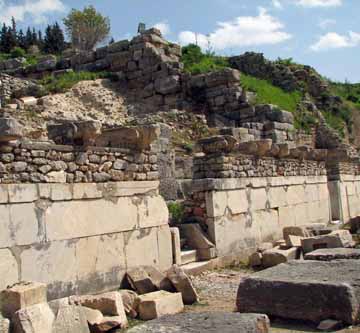 Often
the monuments, shrines, homes and businesses are built into the hill side.
Often
the monuments, shrines, homes and businesses are built into the hill side.


This building has the shape of a small theatre with the stage building, seating places and the orchestra.It had double function in use. First it was used as a Bouleuterion for the meetings of the Boulea or the Senate. The second fuction was the Odeum as a concert hall for the performances.It was constructed in the 2nd century A.D by the order of Publius Vedius Antonius and his wife Flavia paiana, two wealthy citizens in Ephesus.
It had a capacity of 1500 spectators. It had 3 doors opening from the stage to the podium. The podium was narrow and one meter higher than the orchestra section. The stage building was two-storey and embellished with columns. The podium in front of the stage building and some parts of the seating were restored. The Odeon used to be enclosed with a wooden roof.
Two councils administrated Ephesus. These were Demos or the parliament which was open to the public was taken place in the great theatre and the Bouleia which gathered in this small theatre. The members of the boulea were chosen from the aristocratic class of Ephesians. The most important decisions and city matters were discussed here.
 Side streets connected
homes and business, shops and other facilities to the main streets.
Side streets connected
homes and business, shops and other facilities to the main streets.

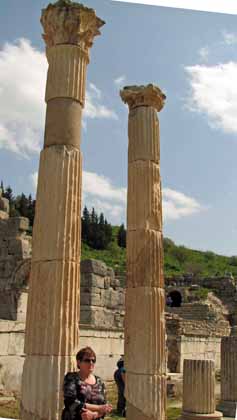

I'm certain every column has a story - if only these stone could talk!
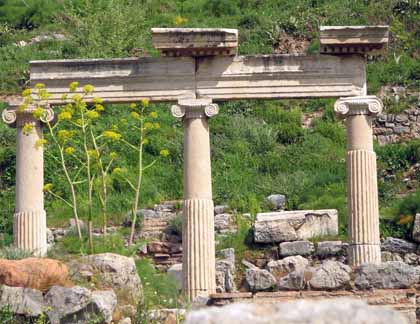
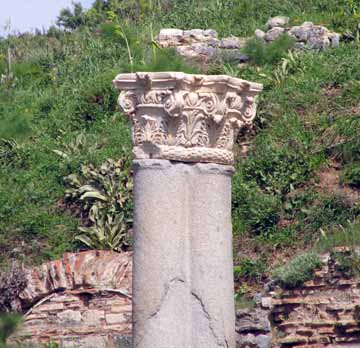 There
are columns everywhere, and as the earlier descriptions indicated, they fell
often and were replaced - so there's several type and ages of design seen.
There
are columns everywhere, and as the earlier descriptions indicated, they fell
often and were replaced - so there's several type and ages of design seen.
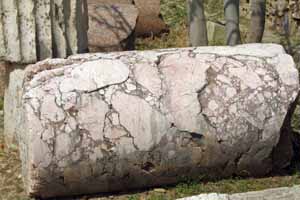 The columns were made of
many materials from many locations. These above were much more of a red
cast that the photo indicates. Below are the remains of many columns laid
out following excavation - notice the different materials and colors.
The columns were made of
many materials from many locations. These above were much more of a red
cast that the photo indicates. Below are the remains of many columns laid
out following excavation - notice the different materials and colors.

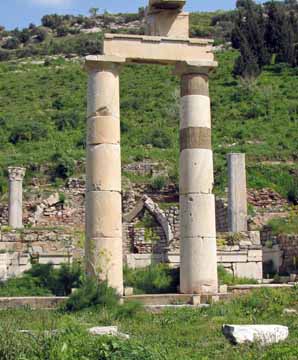
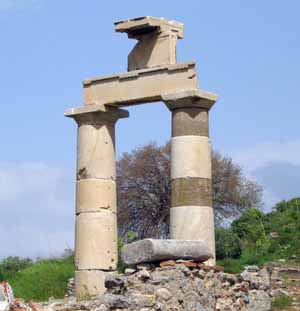
The Prytaneion, where religious ceremonies , official receptions and banquets were held. The sacred flame symbolizing the heart of Ephesus was kept constantly alight in the Prytaneion. The construction of the building dates to the 3rd century B.C, during the reign of Lysimachos, but the ruins of the complex dates to the Augustan age.
The four-cornered pit in which the sacred fire is burned is a relic from the reign of Lysimachos. The front of the building is four columns, beyond the columns is a courtyard surrounded by a portico, and on the north is the center of the building, the ceremonial hall, and its side rooms. The eternal flame was here in the center of the ceremonial hall, the red color on the floor determined the location of the flame. Towards the back, there was a large area with wooden roof, the base of an altar is still recognizable today.
The double columns on the corners of the hall held up the wooden roof. During excavations, archeologists found 2 artemis statues, which are now presented in Ephesus Museum
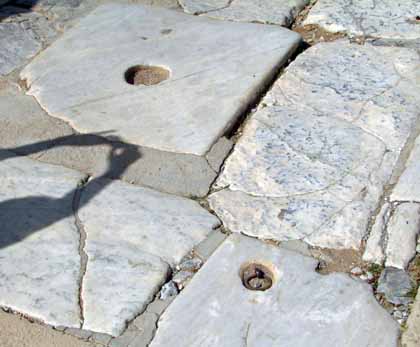
In the middle of the road as it goes down the hill one sees a round hole in the marble and alongside it four other holes with links of chain in them. The central hole held a torch that was never permitted to go out. The four holes with links held the torch in place. The torch could be seen on the hillside for miles and was a guide to mariners towards the port of Ephesus.
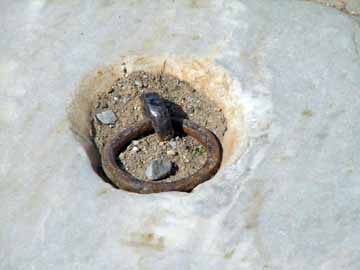
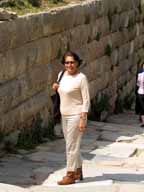
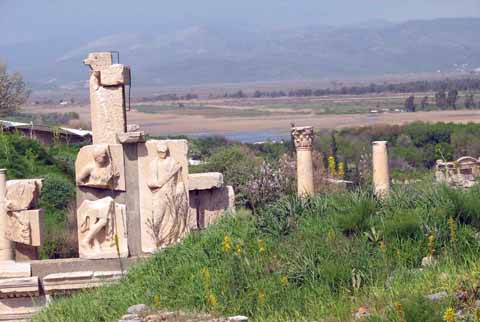

Along the path are carved marble steles. For example, below one sees one of the very earliest medical staffs with the snake curves around it.
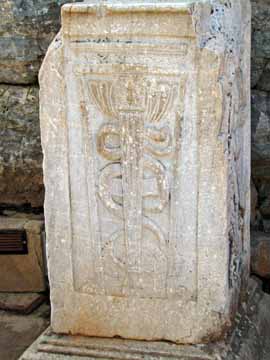
Others have more obscure meanings, if meanings at all, beyond decoration.
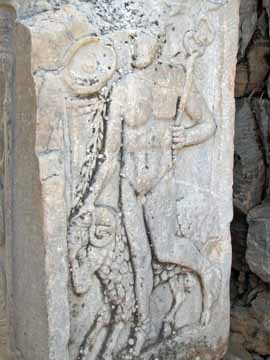


Then there are just pieces of beautiful works. One can only wonder what it might have been.
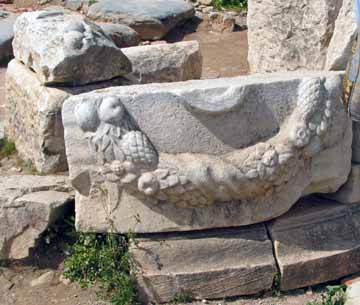
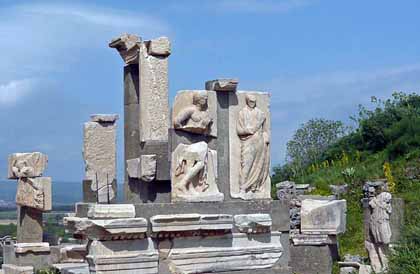
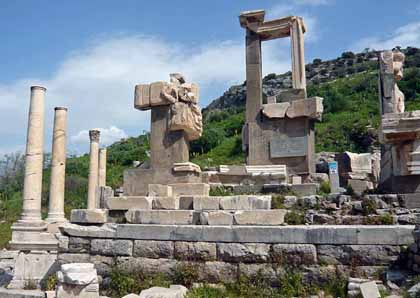
The Pollio Fountain (Below)
The Pollio Fountain was located to the south of the State Agora, across the Odeion. It was built in 97 A.D by the rich Ephesian C.S.Pollio and his family.
The water was brought to the fountains of Ephesus from three main sources through aqueducts and distributed from fountains by a branching system of baked clay pipes. The sources were Kencherios (42km) at Kuşadası, Çamlık village stream of Marnas (15km), and the Cayster River (20km).Water was free of charge by the city in the public fountains. Also they provided refreshment in hot summer days for the streets.
It has a high arch facing the temple of Domitian. It is known to be decorated with a number of statues. One of these statues is the Head of Zeus which is on display in the Ephesus Museum today. Some of these statues were thought to be taken from the Isis Temple, probably after an earthquake, to repair the fountain. The statue group of Odysseus and Polyphemus , that once were on the basin, are now displayed also in Ephesus Museum
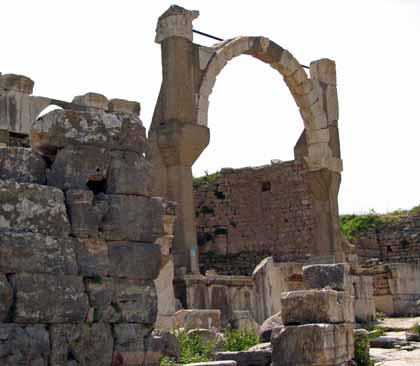
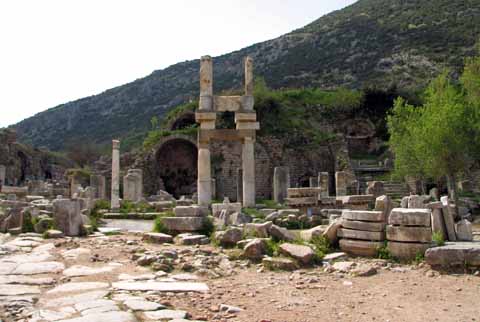
The Prytaneion was one of the most important public buildings in ancient Ephesus. Dedicated to the goddess Hestia, it contained the sacred flame of the city that was never allowed to go out. The Prytaneion was also the place where official visitors were received by dignitaries and where two important statues of the Ephesian Artemis were found.
In Hellenistic and Roman times, Hestia (a.k.a. Vesta), the sister of Zeus and Hera, was honored not just in temples but in every home, as she was goddess of the hearth (the center of domestic worship).
Hestia's sacred fire in the Prytaneion was never allowed to go out, and it was the job of the priests there to tend it. In addition to its religious purpose, the Prytaneion was an important civic building and it was where official guests to Ephesus were received by the religious and civic leaders of the city.
A building existed on this site from the refoundation of Ephesus by Lysimachus in the 3rd century BC, but the structure that can be seen in ruins today dates from the reign of Augustus (27 BC - 14 AD). The cult of Hestia Boulaea was abandoned in the 4th century AD.
The Prytaneion was a large temple-like hall fronted by a Doric courtyard surrounded on three sides by a colonnade. The courtyard was paved with a mosaic depicting the shields of Amazons against a decorative background.
Two of the pillars that have been re-erected bear inscriptions with the names of the Curetes. Scholastica took columns and other materials from the Prytaneion for the construction of her baths on Curetes Street in the 4th century.
Two statues of the Ephesian Artemis were discovered in the Prytaneion and are now displayed in the Ephesus Museam. The larger statue, dating from the 1st century AD, was in the hall. The other, dating from about 50 years later, had been carefully buried in a small room in the sanctuary.


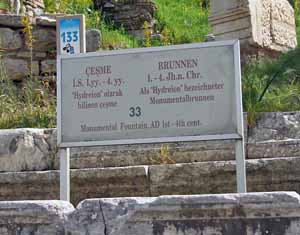





The Hercules Gate
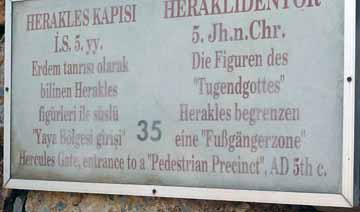
Located towards the end of the Curetes Street, it was called the Hercules gate because of the relief of Hercules on it. It was brought from another place in the fourth century AD to its current place, but the relief on it dates back to the second century AD.
Only the two side of the columns remain today and the other parts of it have not been found. The relief of the flying Nike in the Domitian Square is thought to also be a part of this gate.
The Heracles Gate narrowed the access to the street, preventing the passage of vehicles. We can understand that from the Fourth Century, the street had become a pedestrian area.
In these reliefs Heracles was depicting with the skin of the Nemean lion in mythology. The Nemean lion had been terrorizing the area around Nemea, and had a skin so thick that it was impossible to kill it. Finally he wrestled the lion to the ground, eventually killing it by thrusting his arm down its throat and choking it to death. Heracles was the god of power and strength.
The Hercules Gate - showing Hercules draped in a lion skin - originally a two storey structure.

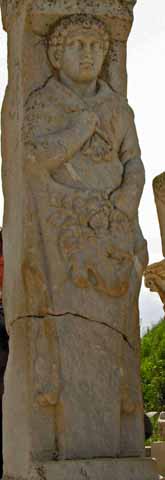

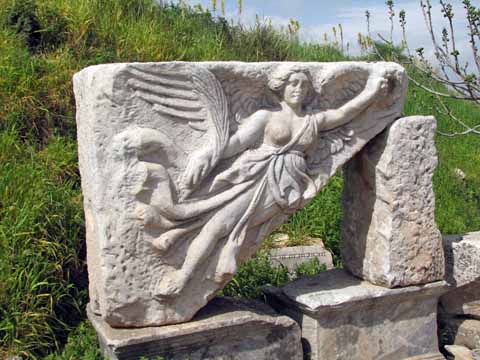
Winged angel of victory at Hercules' gate. This triangular-shaped architectural element comes from the Door of Hercules at the start of Curetes Street. The sculptural represents Winged Nike, the Goddess of Victory, holding a crown in her left hand.
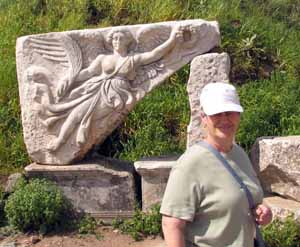
It is one of the three main streets of Ephesus between The Hercules Gate till to the Celsus Library.This street took its name from the priests who were called as Curetes later.Their names were written in Prytaneion.
There were fountains, monuments, statues and shops on the sides of the street. The shops on the south side were two-storied. Ephesus had many earthquakes, in which many structures including the Curetes Street were damaged. These damages especially on the columns were restored by the new ones, but after the earthquake in the 4th century, the columns were replaced by the other ones brought from different buildings in the city. The differences between the design of the columns can be seen today. The street has its appearance from the 4th century.
There were also many houses on the slope. These were used by the rich of Ephesians.Under the houses there were colonnaded galleries with mosaics on the floor were located in front of the shops with a roof to protect the pedestrians from sun or rain.
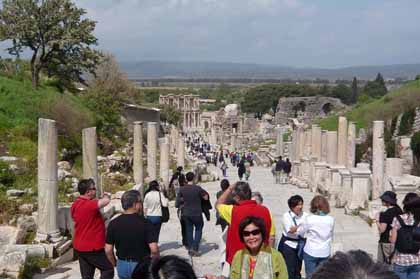
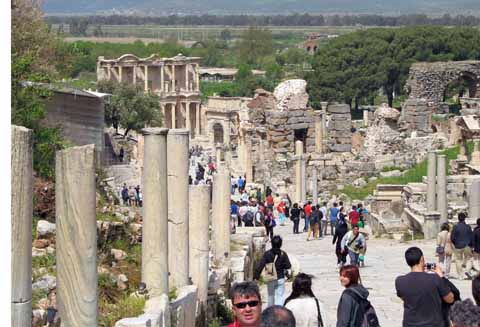
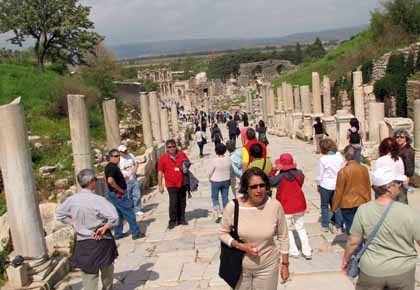
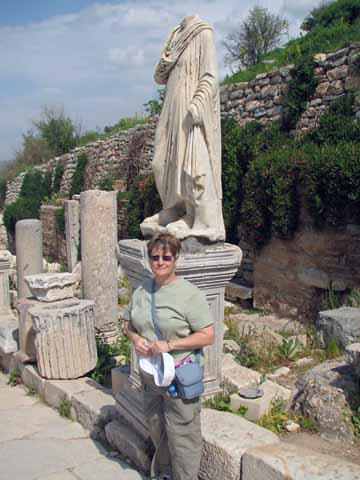
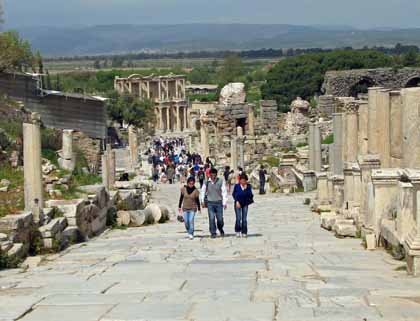
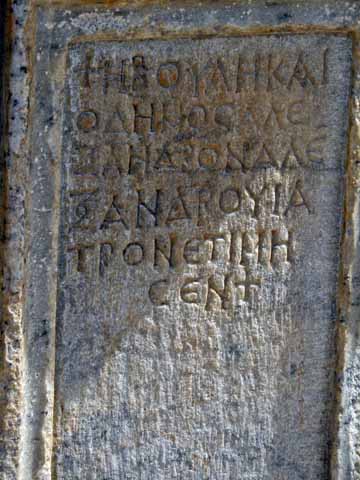
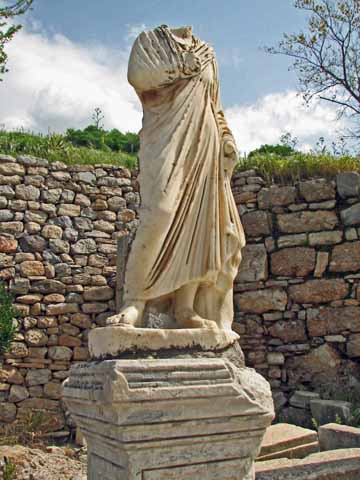
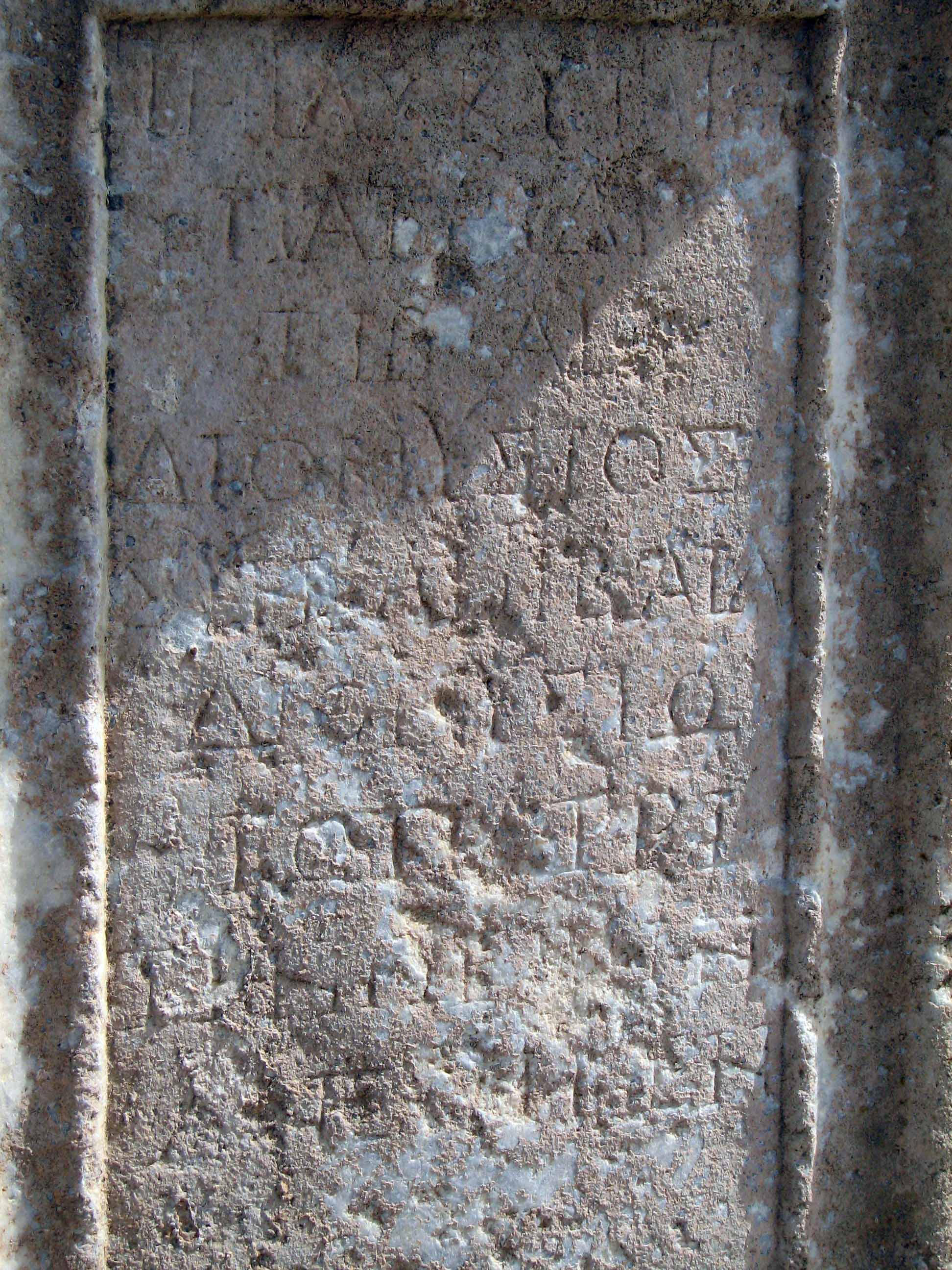

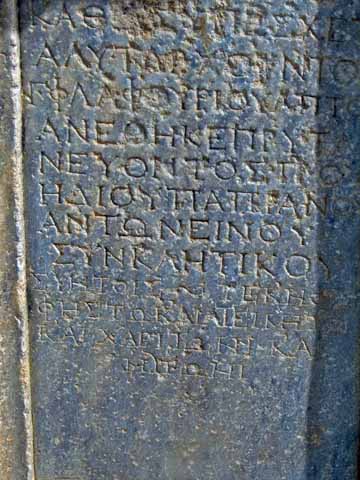
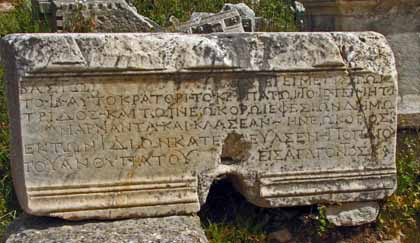
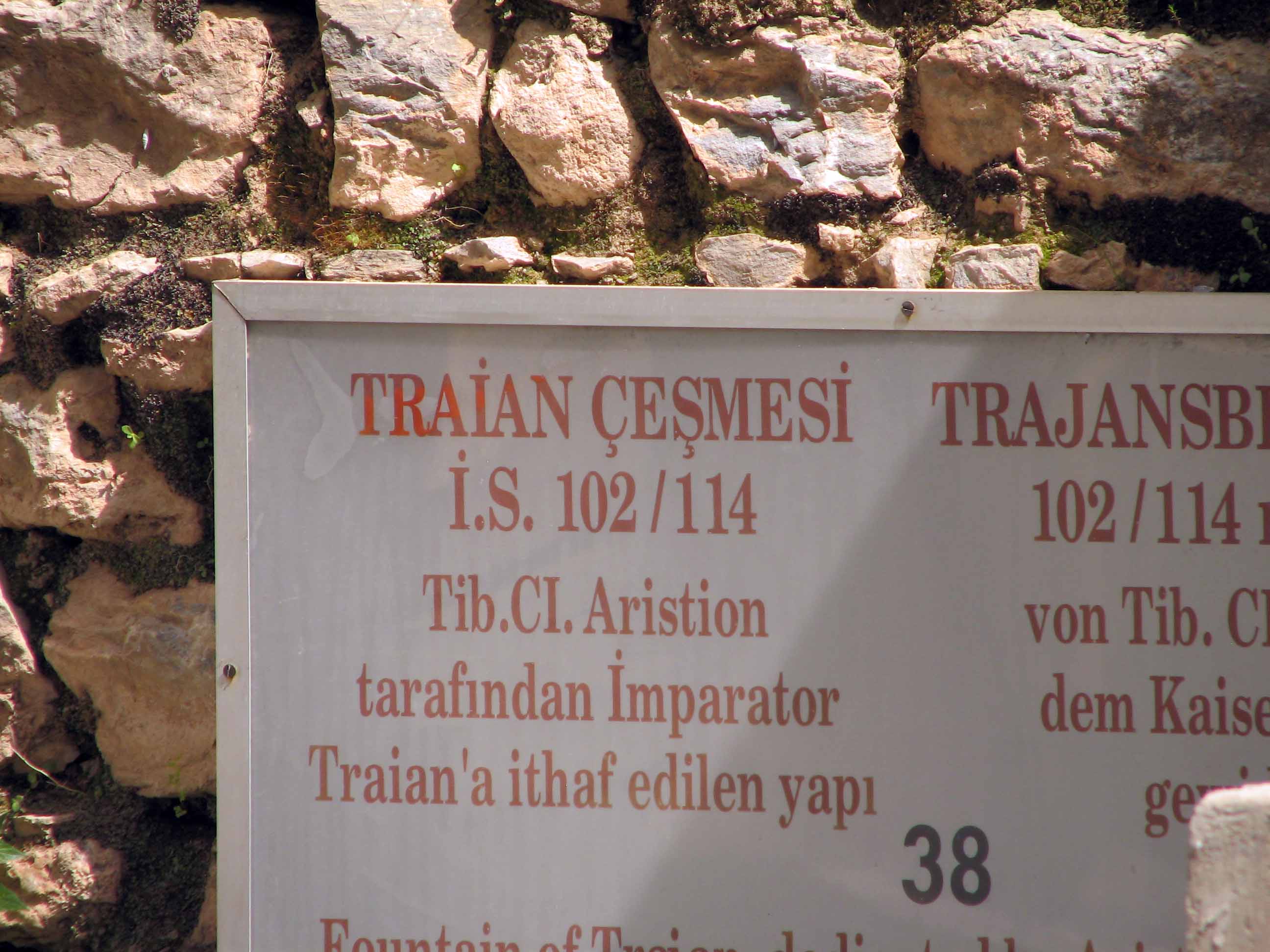
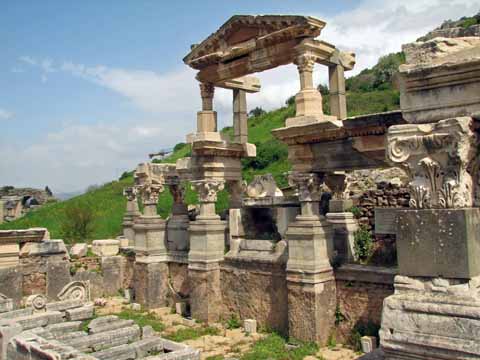
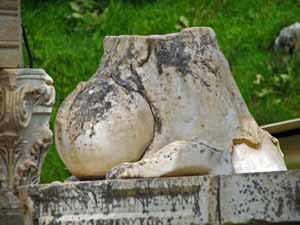
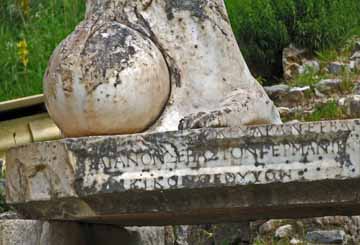
The Slope Houses
Behind the shops on the south side of Curetes Street near the Library of Celsus are luxurious private houses, known as the Slope Houses for their location on the slopes of Mt. Coressus (Bulbuldag). Occupied from the 1st century to 7th century AD, the Slope Houses have been compared to the 1st century villas of Pompeii in importance.
The Slope Houses are also known as the Terrace Houses and Hanghausen (in German, because the archaeologists are Austrian).
The Slope Houses were used from the 1st century to 7th century AD, and then were abandoned. Around this time, after the devastating Arab raids and the continued silting up of the harbor, the remaining inhabitants of Ephesus moved to Ayasuluk hill (near the Basilica of St. John).
After being abandoned, the Slope Houses gradually fell into decay. However, a number of them were filled with soil from landslips, which preserved them and their contents.
The houses at Ephesus are not inferior to those found at Pompeii and Herculaneum in terms of preservation and importance. Their decor and furnishings provide a great deal of information about the lifestyle of the Ephesian upper class in the Roman and Byzantine periods.
The Slope Houses are still being excavated and are sometimes covered by a tent, but are usually open to the public. They can be reached by a flight of steep steps from Curetes Street. The ruins have been divided by archaeologists into Slope House 1 (south) and Slope House 2 (north, closer to the Library). Each house had three stories, running water, heating, and an atrium with an entrance onto the side street.
In Slope House 1, room A1 has a fine black-and-white mosaic. Room A2, the atrium, has a marble floor with the remains of a fountain in the center. The walls of rooms A10 and A11 are decorated with frescoes.
The most interesting room in this house, though, is A3, dubbed the "theater room" based on the theatrical subjects of its frescoes. One of the owners of the house may well have overseen theater performances in Ephesus for a living. The right-hand wall has a scene from Menander's comedy, Perikeiromene ("The Girl Who Gets her Hair Cut"), and the left wall bears a scene from Euripides' Orestes.
The room also contains a fine fresco of the mythological battle between Hercules and the river god Achelous for the hand of Deianeira. The shape-shifting Achelous assumed the form of a dragon and of a bull during the struggle, and only accepted defeat when Hercules tore off one of his horns.
Slope House 2 is larger than its neighbor. Built in the 1st century AD, it was altered and extended several times before being abandoned in the 6th century. Many of its rooms feature mosaics and frescoes. Rooms B9 and B10 have frescoes of the muses. The house has two atria, the larger of which has several fine Corinthian columns lining a passageway paved with a beautiful mosaic of a triton and sea-nymph.
The most interesting room in Slope House 2 is the atrium, because of a beautiful and unusual 5th-century glass mosaic in a niche. The niche is flanked by a decorative fresco of erotes supporting a garland. Inside the niche is a delicate glass mosaic of the heads of Dionysus and Ariadne against a background of luxuriant foliage and an array of glittering animals and birds. As the light changes, the glass tiles sparkle and glow, making the figures in the mosaic appear to move. The late date indicates the owners were likely Christians, making the pagan subject interesting.


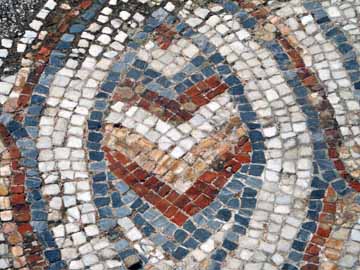
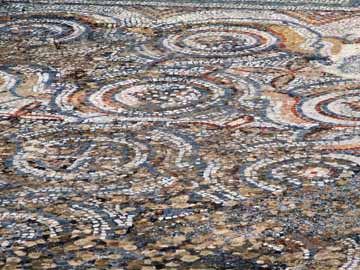
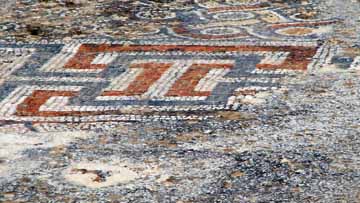


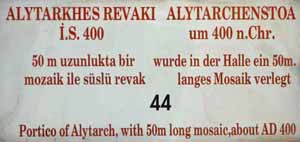
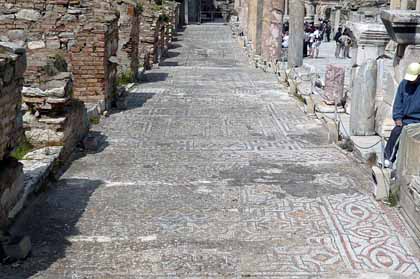

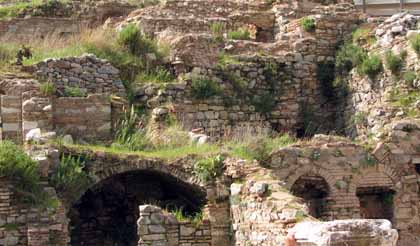
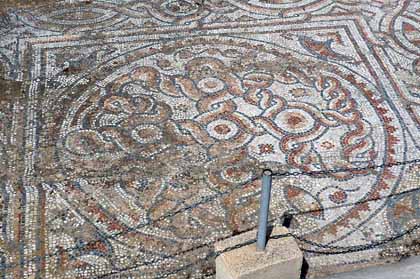

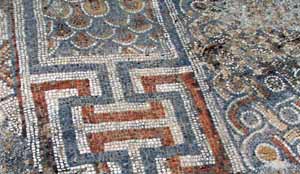
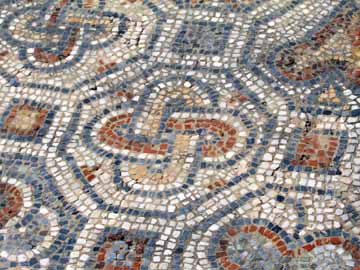


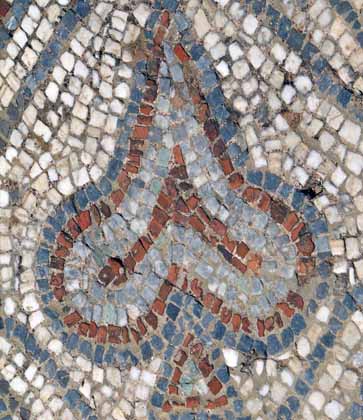
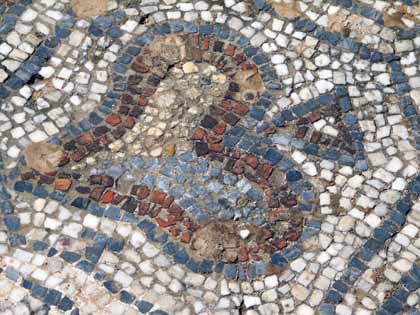

additional views as we walk
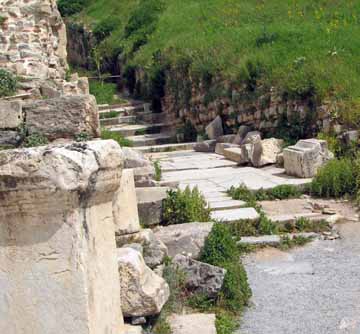
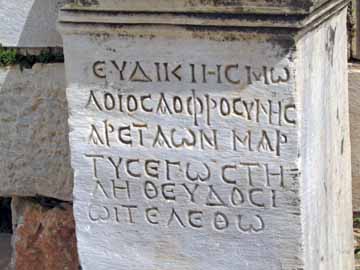


Below you will see the Temple of Hadrian
The Temple of Hadrian is one of the main attractions atEphesus, with a beautiful arch on the front facade and interesting reliefs of Medusa and other scenes inside.
An inscription tells us the temple was erected around 118 AD by one Publius Quintilius (who is otherwise unknown).
The name "Temple of Hadrian" is not really accurate: it is more a monument than a temple, and was dedicated not only to Hadrian but also Artemis and the people of Ephesus.
The temple was partially destroyed in the 4th century, and it was during the course of restorations that the four decorative reliefs were added to the lintels of the interior of the porch.
The small, simple structure consists of just a pronaos (porch) and small cella (main hall). The porch is supported by two pillars and two columns of the Corinthian order.
The architrave contains the dedicatory inscription from Publius Quintilius to Hadrian, Artemis and the people of Ephesus, and includes a bust of the goddess Tyche, protectress of the city. The pediment and decorative frieze of the pronaos have disappeared.
In the arched tympanum over the main portal is a carving of a half-nude woman surrounded by acanthus leaves; some identify the figure as Medusa, symbolically keeping evil spirits away.
The cult statue of Hadrian once stood on a low podium at the end wall of the cella, but has been lost. The bases in front of the porch facade are inscribed with the names of Galerius, Maximianus, Diocletianus, and Constantius Chlorus, indicating that the bases originally supported statues of these emperors.
The interior of the monument is decorated with panels of reliefs along the top. The ones in place today are plaster replicas of originals protected in the Ephesus Museum
The first three panels from the left depict the mythological foundation of Ephesus, and show representations of Androklos chasing a boar (part of the founding myth of Ephesus), the battle between Hercules and Theseus, and gods with Amazons. Most of these were taken from a 3rd-century building and placed here in the 4th-century reconstruction.
The fourth panel was created new at the time of the 4th century reconstruction, and is very interesting for the religious history of Ephesus. It shows Emperor Theodosius (who outlawed paganism) and his family surrounded by Athena, Apollo, Androklos, Heracles, Artemis of Ephesus, and several other historical and mythological figures.
In 381, the Christian Emperor Theodosius outlawed pagan cults throughout the empire. Not long after this, a curious relief was added to the so-called Temple of Hadrian in Ephesus. It shows the great anti-pagan campaigner Theodosius and his family accompanied by gods including Artemis of Ephesus, Athena and Selene!
In light of the themes of the other reliefs on the same structure, which include such founding legends as the wild boar hunt of Androklos, it may be the relief is not primarily religious in nature but rather "indicates that he [Theodosius] was regarded as the new founder of Ephesus." The imagery of the gods may thus be intended as symbols of the city and of traditional legends rather than a religious statement.
Still, the combination of such an anti-pagan Christian figure with the old gods certainly demonstrates the lack of violent opposition towards the latter that will become prominent in the fifth century. And indeed, paganism was by no means a thing of the past in Ephesus by the end of the fourth century. In 1992, excavators discovered a grave house that was in use from 260 to 408. It had been robbed but some artifacts remained, and none were Christian.
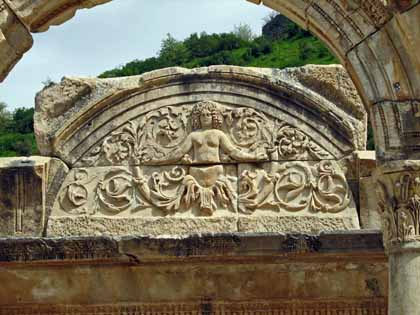
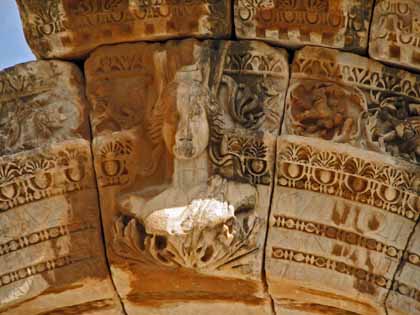
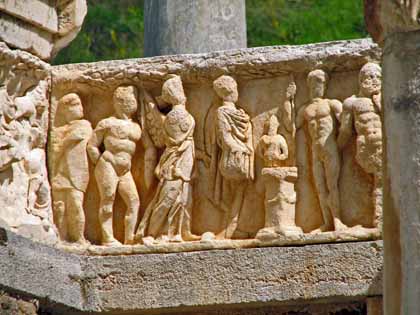
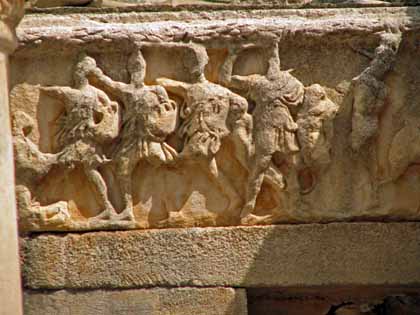




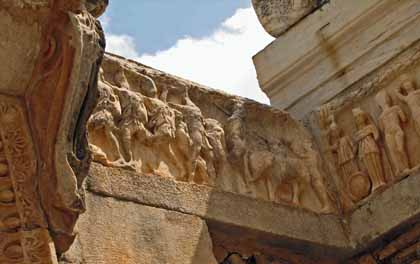
There are beautiful cared stone everywhere you look


At the archaeological site of Ephesus, a well-paved road heading east of the Vedius Gymnasium leads to the Cave of the Seven Sleepers, about .8km (1/2 mile) away.
The "Seven Sleepers" were seven young men who had been walled up in a cave during the persecutions under Decius (c.250). They fell asleep, miraculously waking up around 435 in the time of Theodosius II.
The seven men wandered into the city of Ephesus, amazed at all the churches and the freedom of worship for Christians. The Sleepers later died naturally (and permanently) and were buried in the cave in which they had slept.
The miracle was apparently first described by Bishop Stephen of Ephesus (448-5). 1It seems to have been immediately accepted, perhaps in part because of its usefulness for a current Origenist controversy having to do with the resurrection of the body. Interestingly, the Seven Sleepers also appear in the Qur'an (Koran); in this version, the boys are accompanied by a dog (Sura 18).
The grotto associated with the Seven Sleepers, located on the eastern slope of Panayirdag hill, became a highly venerated site and a major place of pilgrimage from the 5th to 15th centuries. Many people were buried in the grotto with the Sleepers. A brick church was built above the seven original tombs, with mosaic floors and marble revetments. A large, domed mausoleum was added to the cave in the 6th century.
Excavations were carried out in the Grotto of the Seven Sleepers between 1927 and 1930. Intriguingly, the archaeologists discovered that the cave complex predates the legend by several centuries. An abundance of lamps found in the Grotto date from before the 5th century, and not all of them are Christian.
The Grotto of the Seven Sleepers is fenced off, but a large hole in the fence currently provides full access to the cave. The site is a bit off the beaten track, but still visited by many pilgrims and tourists. There is a small restaurant nearby.
The main part of the complex is the cave church in which the Seven Sleepers slept and were buried. The large cave, with a ceiling as high as many regular churches, has been lined with brick masonry to form a church. There are arch niches on the sides and a rounded apse in the back. The burial places of the sleepers in the floor are now open, empty holes.
Although it cannot be appreciated at the site, one of the most interesting aspects of the Grotto is the treasure trove of terracotta lamps that was discovered inside. They date primarily to the 4th and 5th centuries. Most of the lamps are decorated with a cross; others bear scenes from the Old Testament popular with Christians, such as Adam and Eve, Abraham and Isaac, and Daniel in the lions’ den. There are also a wide variety of secular scenes, such as fishermen and theatre performances.
But alongside these are pagan religious scenes such as Hercules and the lion, Zeus and Aphrodite, pictures of temple facades, and the head of the god Attis. Were these lamps made and used by Ephesians who considered themselves Christians but retained pagan traditions, or did pagans join Christians in devotions at the Cave of the Seven Sleepers? The answer is not clear, but either way it is evidence that paganism was still alive in 5h-century Ephesus.

I believe I do not have a complete picture of the Octigon, but I believe (hope) this is what Jackie is standing alongside. The Octigon has a facinating history.
Octagon was a vaulted burial chamber placed on a rectangular base with the skeleton of a 15 or 16 year old woman in a marble sarcophagus. According to an interpretation Octagon was a monument to Ptolemy Arsinoe IV, the youngest sister of the famous Cleopatra VII,was murdered in Ephesus in 41 BC.
Arsinoe IV (ca. 68/67 – 41 BC) was the fourth daughter of Ptolemy XII Auletes, sister of Ptolemy XIII and Cleopatra VII, and one of the last rulers of the Ptolemaic dynasty of ancient Egypt. When their father died, he left Ptolemy and Cleopatra as joint rulers of Egypt, but Ptolemy soon dethroned Cleopatra and forced her to flee Alexandria.
When Julius Caesar arrived in Alexandria in 48 BC and sided with Cleopatra's faction, Arsinoe escaped from the capital with her mentor Ganymedes and joined the Egyptian army under Achillas, assuming the title of pharaoh. When Achillas and Ganymedes clashed, Arsinoe had Achillas executed and placed Ganymedes in command of the army. Ganymedes initially enjoyed some success against the Romans, negotiating an exchange of Arsinoe for Ptolemy, but the Romans soon received reinforcements and inflicted a decisive defeat on the Egyptians.
Arsinoe was transported to Rome, where she was forced to appear in Caesar's triumph. Despite usual traditions of prisoners in triumphs being strangled when the festivities were at an end, Caesar spared Arsinoe and granted her sanctuary at Ephesus. Arsinoe lived in the temple for many years, always keeping a watchful eye for her sister Cleopatra, who saw her as a threat to her power. Her fears proved well-founded; in 41 BC, at Cleopatra's instigation, Mark Antony ordered her executed on the steps of the temple. She was given an honorable funeral and a modest tomb.
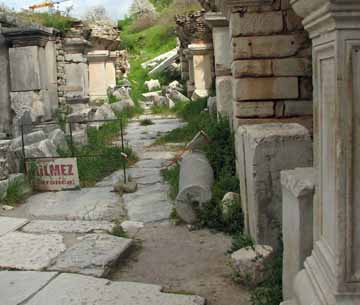
Roman Brothel and Latrine
The brothel and public latrine of ancient Ephesus are located directly across Marble Street from the Library of Celsus. Both date from the 1st century AD. Of course neither of these are a sacred site, but these less glamorous structures help bring ancient Ephesus to life.
The brothel originally had two floors, with ground floor entrances on both Marble Street and on Curetes Street. On the latter, an etched footprint in the marble famously shows the way.
The rooms of the ground floor, one of which has a stone bed, were built around a small atrium. The floor of the main reception room was covered with a mosaic of the four seasons. The personified figures of Winter (with head covered) and Autumn (with a garland of flowers) are still well preserved. The cubicles used by the prostitutes to entertain their clients were on the upper floor.
The ithyphallic figurine of Priapus or Bes, now in the Ephesus Museum, was found in a well on the side of the brothel near Curetes Street. The well is still in use. Of Egyptian origin, Bes was not the god of the brothel, but the protector of everything associated with motherhood and childbearing.
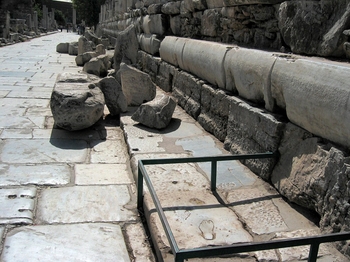
Footprint marking the way to the brothel.
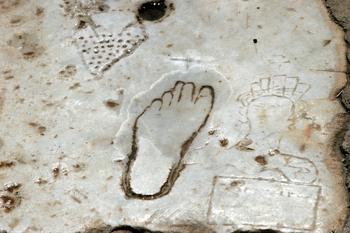
Closer look at the marker.
On the marble road, there are some drawings believed to be an advertisement of the Brothel. This advertisement is known as the first advertisement in history. There is a footprint on the advertisement, one finger showing the library, and other showing the brothel. The known explanation of this sign is that the footprint shows that one should turn at that point; the woman's head symbolizes the women waiting in the Brothel and the heart shows that the women are eager for love.

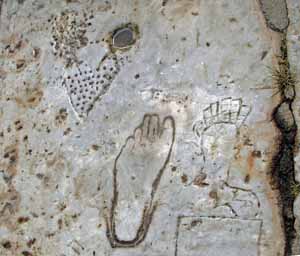
The Latrine
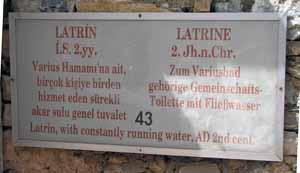
The 1st-century Roman latrine of Ephesus was rather advanced and civilized for its time. It was constructed over a channel with an uninterrupted flow of water and the toilet seats, formed by cutting holes into marble benches that line the walls, were covered by a roof.
The rest of the large room was open to the sky, and had an impluvium (a sunken pool for catching rainwater) in the center. The floor was covered with mosaics.
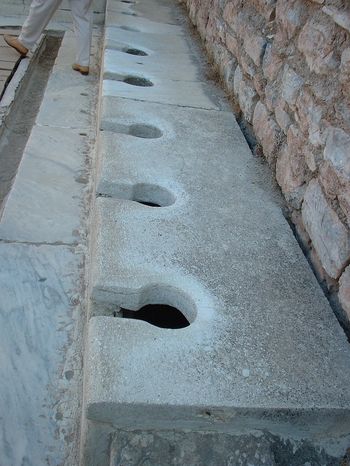
Closer look at the latrine
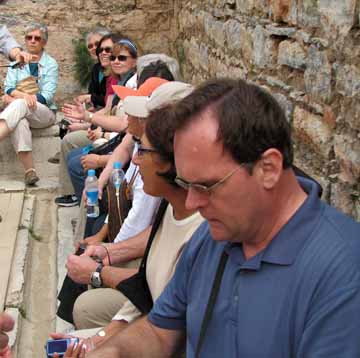 No! They're just tired and these are the perfect height to sit & rest.
No! They're just tired and these are the perfect height to sit & rest.
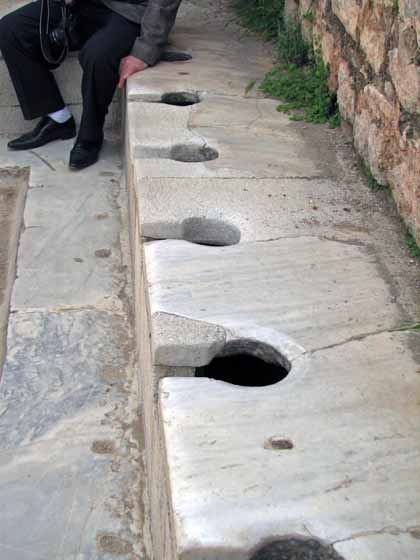
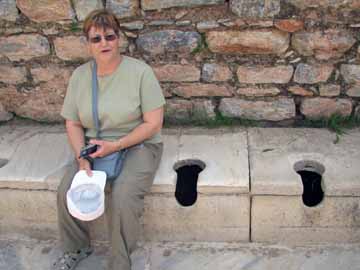 Hot and tired.
Hot and tired.
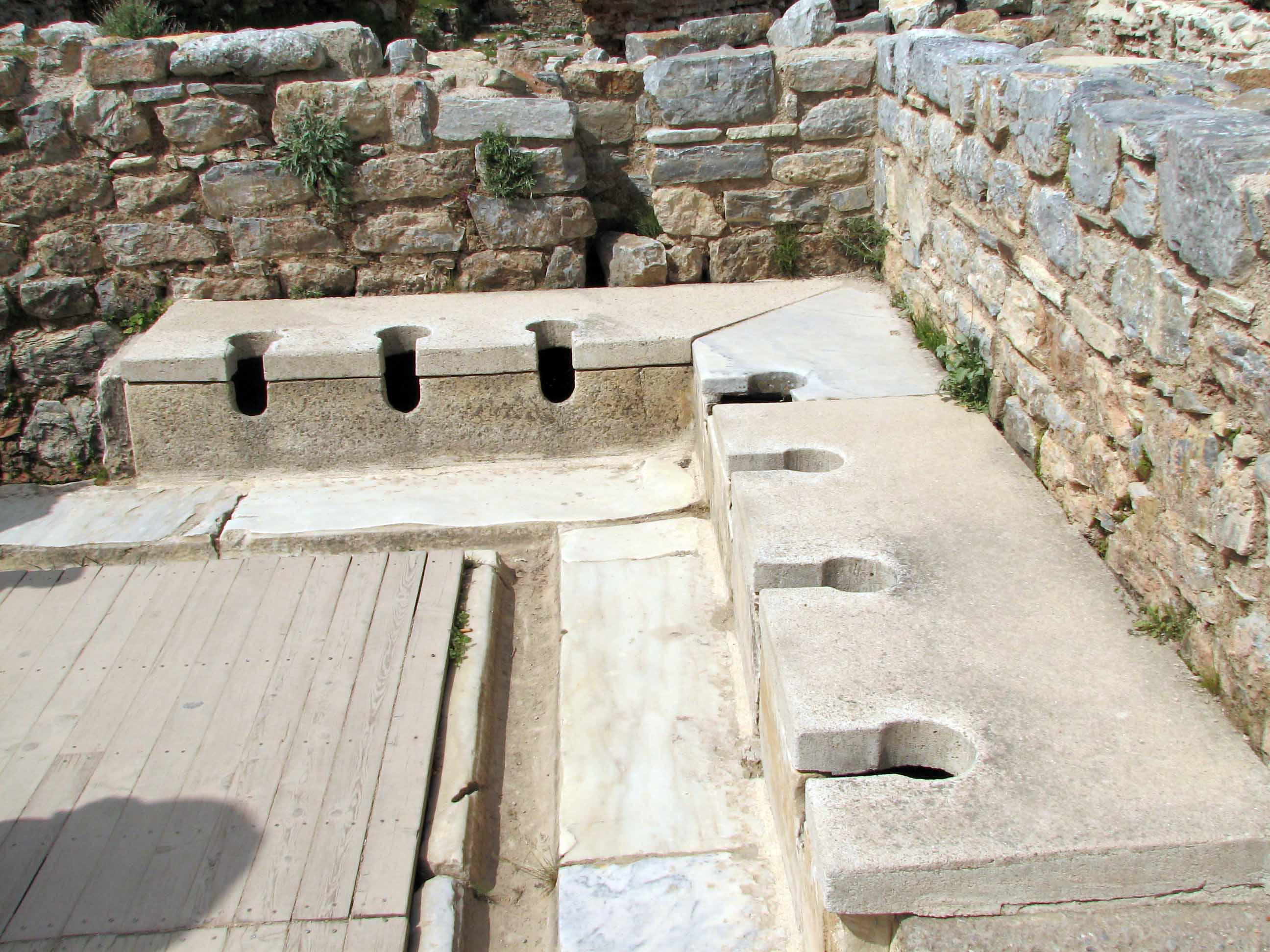
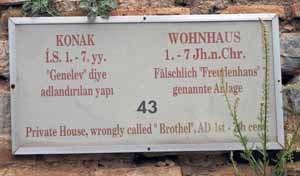
Maybe - Maybe Not

Another game cut into the marble curb.
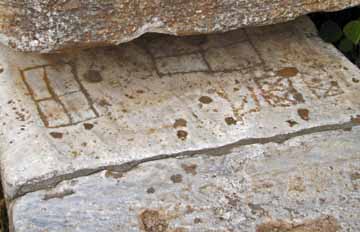

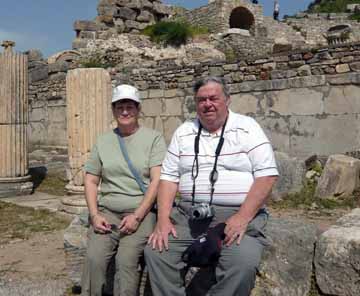
One of the great The show-pieces of Ephesus
The LIBRARY OF CELSUS
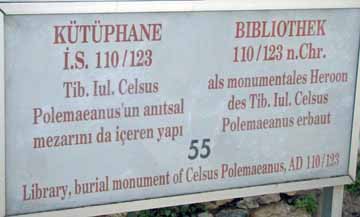
The Library of Celsus is a Roman mausoleum and library built in the early 2nd century AD. As one of the most beautifully reconstructed buildings in Ephesus, it has become an icon of the ancient city.
The Library of Celsus was comissioned by the Consul Julius Aquila as a mausoleum for his father, Julius Celsus Polemaeanus, Roman governor of the Asian Provinces. It may be that Celsus was granted heroic honors, which would furthur justify the expense.
The monument was constructed between 110 and 135 AD, after which Celsus was buried in a niche on the right side of the back wall.
With a few centuries of its construction a fire destroyed the reading room and the library fell into disuse. Around 400 AD, the courtyard below the exterior steps was converted into a pool. The facade collapsed in an earthquake in the 10th century.

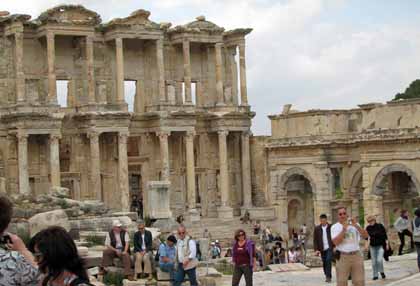
The Library of Celsus was raised from the rubble to its present splendid state by F. Hueber of the Austrian Archaeological Institute between 1970 and 1978.
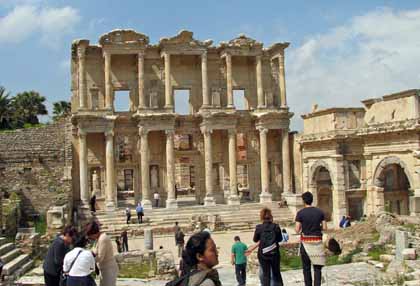

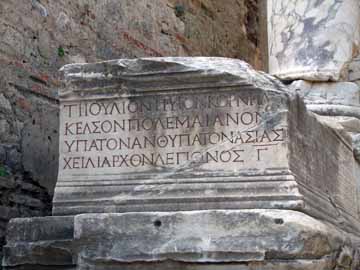
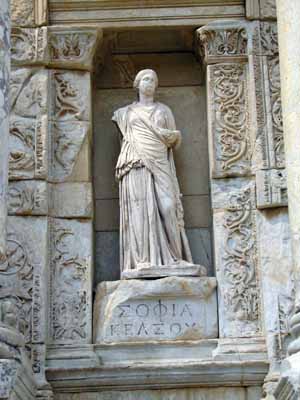

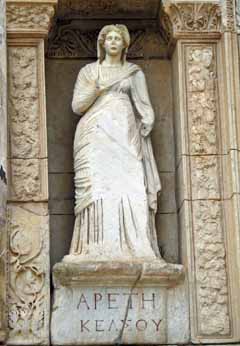
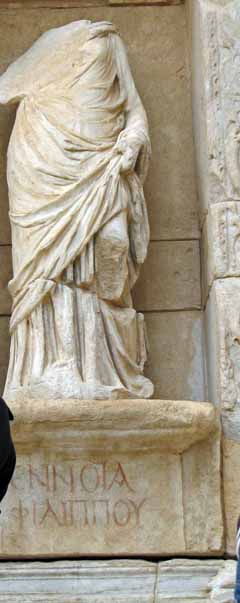



Additional ruins and wonderful works of carved stone
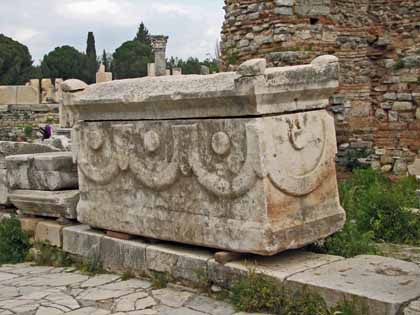
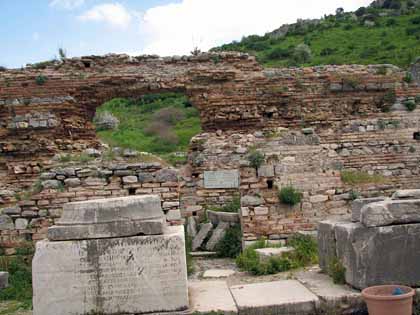
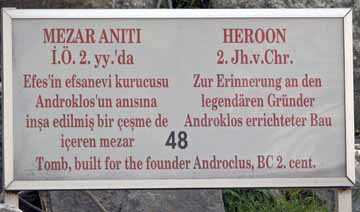


An other game site cut into the curb
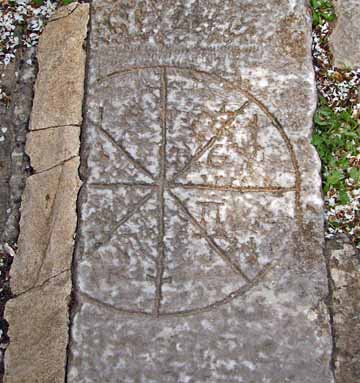
Hadrian's Gate
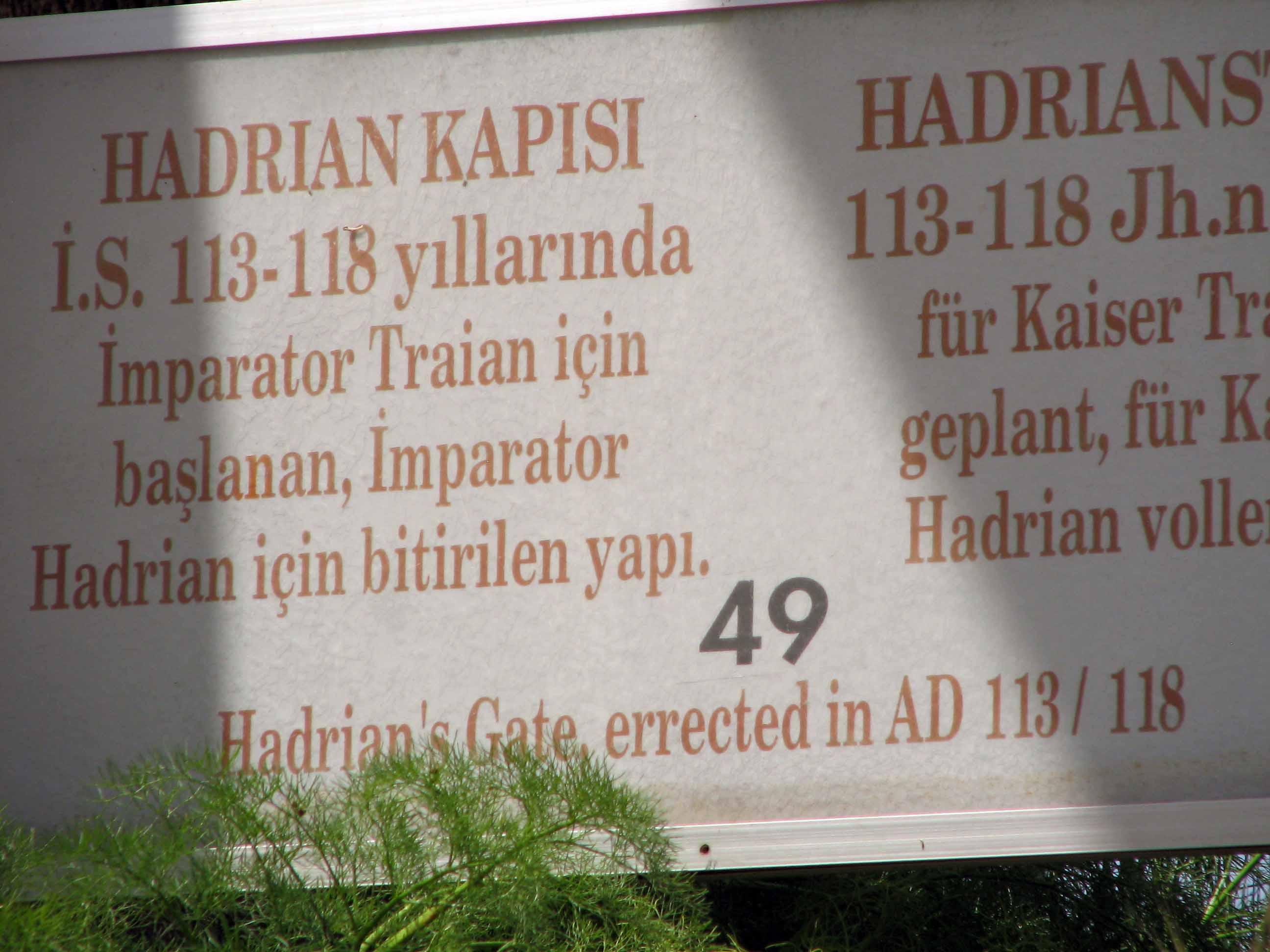


Looking back up the hill.
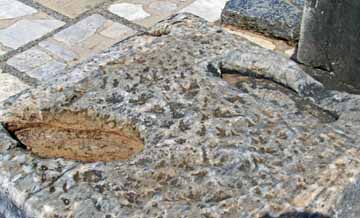 After
seeing Rome, we recognize this as the base on which a statue was set. The
"foot prints" were the sockets into which the feet of the statue were
set.
After
seeing Rome, we recognize this as the base on which a statue was set. The
"foot prints" were the sockets into which the feet of the statue were
set.
The Agora Gate
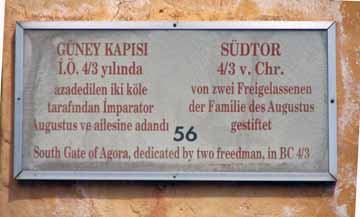
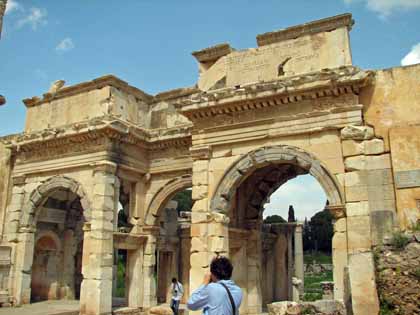
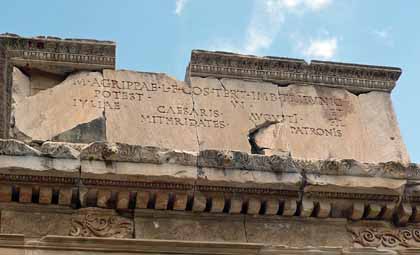
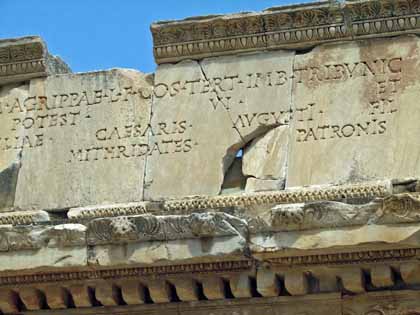
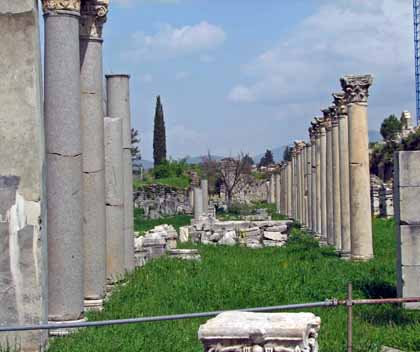
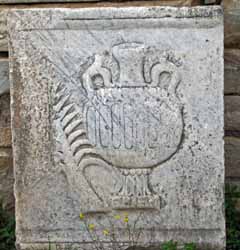
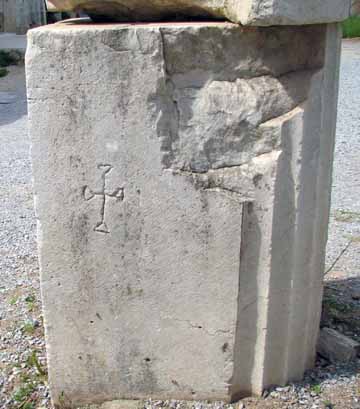
Walking below the Agora Gate I found a mark on the base of a statue that I can only assume is a Crusader Cross carved as graffiti by a Crusader.
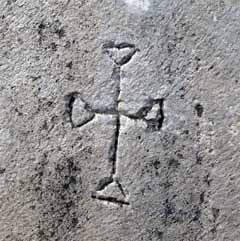
Artemis was a Greek Goddess, the virginal huntress and twin of Apollo, who supplanted the Titan Selene as goddess of the Moon. Of the Olympian goddesses who inherited aspects of the Great Goddess of Crete, Athena was more honored than Artemis at Athens. At Ephesus, a goddess whom the Greeks associated with Artemis was passionately venerated in an archaic, certainly pre-Hellenic Cult image that was carved of wood and kept decorated with jewelry. Robert Fleischer identified as decorations of the primitive xoanon the changeable features that since Minucius nd Jerome's Christian attacks on pagan popular religion had been read as many breasts or "eggs" — denoting her fertility (others interpret the objects to represent the testicles of sacrificed bulls that would have been strung on the image, with similar meaning). Most similar to Near-Eastern and Egyptian deities, and least similar to Greek ones, her body and legs are enclosed within a tapering pillar-like term, from which her feet protrude. On the coins minted at Ephesus, the apparently many-breasted goddess wears a mural crown (like a city's walls), an attribute of Cybele. On the coins she rests either arm on a staff formed of entwined serpents or of a stack of ouroboroi, the eternal serpent with its tail in its mouth. Something the Lady of Ephesus had in common with Cybele was that each was served by temple slave-women, or hierodus (hiero "holy", doule "female slave"), under the direction of a priestess who inherited her role, attended by a college of eunuch priests called "Megabyzoi and also by young virgins.
(For additional Artemis pictures and a story - See "A Mystery Solved" in the Odds and Ends page. This exhibit was hidden from view in a dark, damp tunnel like area, the entrance closed by a chain link fence and covered with canvas. I believe few, if any others, saw this statue) )
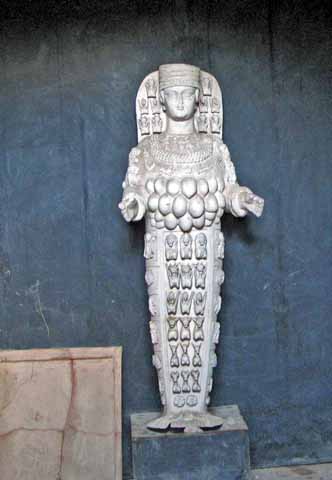


To the right you will see the Gate of Mazeus and Mythridates. The gate with three passage ways at the right of the Celsus Library was built in 40 A.D by the slaves Mazeus and Mythridates for their emperor, Augustus, who gave them their freedom.
This gate, built almost entirely of marble, was dedicated in 3 B.C. to Augustus and his son-in-law Agrippa by two rich freedmen of the city Mazeus and Mithridates. These two imposing gates leading into the agora constitute the finest example of restoration work carried out in recent years
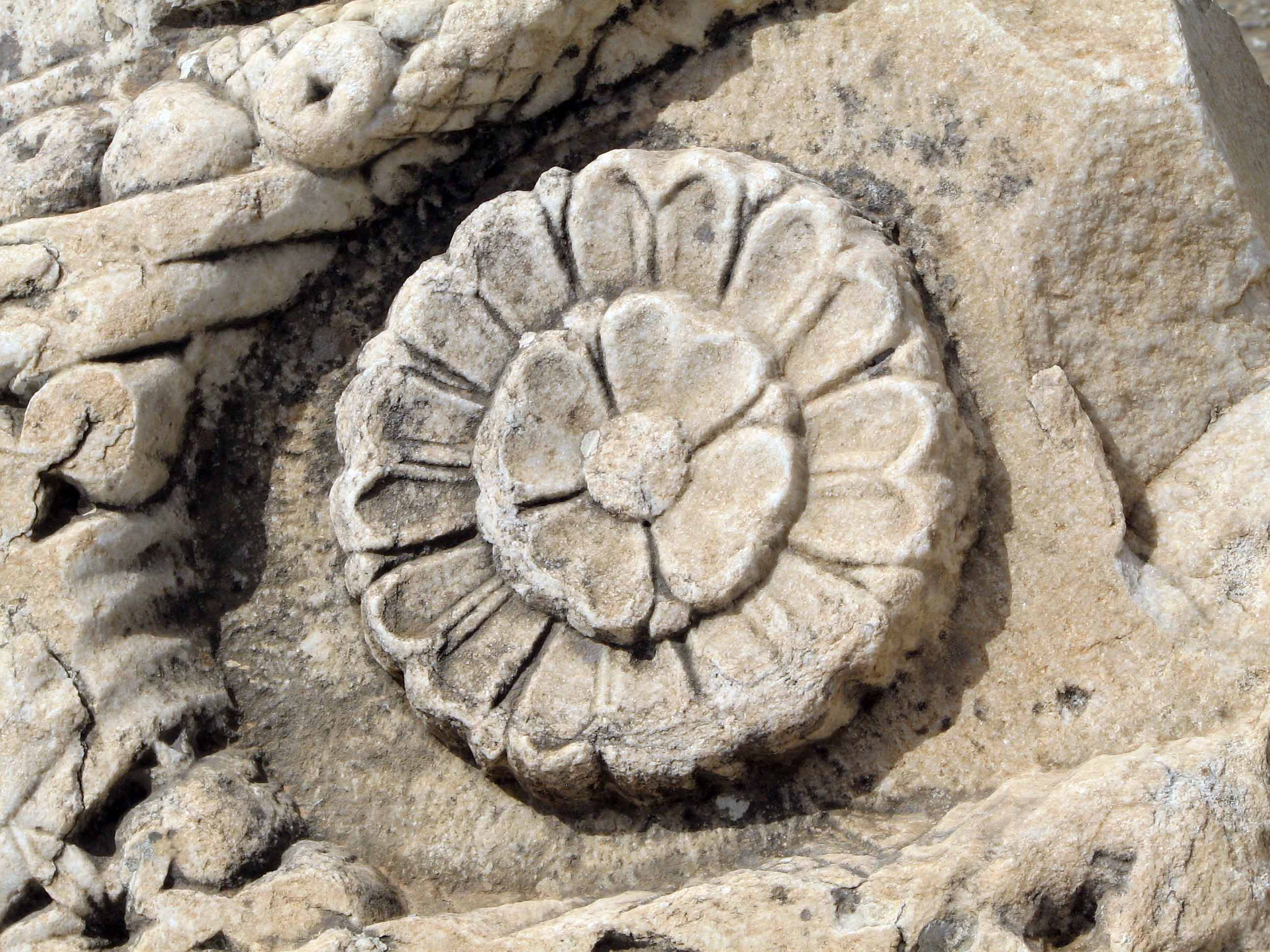


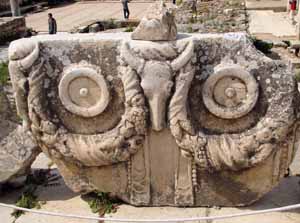
Along the street were stone signs. While I could not interpret them all, the one to the right, above, was the store-front of an armorer.

This street, 600 m lonng and 11 m wide, was given this name after its restoration by the Emperor Arcadius (395-408). The main street of the city connecting the theatre land the surrounding area to the port, it was flanked by stoas with mosaic floors. These colonnades, whIch included a row of shops, served to protect the. inhabitants of the city from wind and rain in the winter and from the sun in the summer. Inscriptions oh four imposing Corinthian columns erected by the Emperor Justinian (525-566) indicate the existence of sculptures of the four Evangelists. An inscription in the theatre informs us that the street was illuminated by two rows of torches.

As indicated, I'm fascinated by carved inscriptions - even if I have no chance of interpreting them. This one caught my eye as it has two Greek inscriptions, one beneath the other, and beneath both an Armenian inscription. I give anything to know what was said, and why!
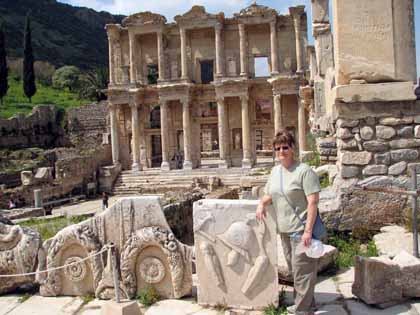
The Agoras

Being the most important trade center of Ephesus, Agora was built in the third century B.C in the Hellenistic Period, but the ruins date from the reign of Caracalla (211-217 C.E)
It is in the form of a square, each side 110 meters, and surrounded completely by columns. The Agora has 3 gates, one from the front of the theatre on the northeast, the other one opening to the harbor on the west and the third one from the Celsius Library. The north side of the Agora is left open, and the other three sides are surrounded by a portico, in which there are rows of shops. At the center of the Agora was a sundial and a water-clock.
The Agora (GreeK: Ἀγορά, Agorá) was an open "place of assembly" in ancient Greek city-states. Early in Greek history (10th century–8th century BC), free-born male land-owners who were citizens would gather in the Agora for military duty or to hear statements of the ruling king or council. Later, the Agora also served as a marketplace where merchants kept stalls or shops to sell their goods amid colonnades. From this twin function of the Agora as a political and commercial space came the two Greek verbs αγοράζω, agorázō, "I shop", and αγορεύω, agoreýō, "I speak in public". The word agoraphobia, the fear of critical public situations, derives from Agora in its meaning as a gathering place.
The Fum was the Roman equivalent of the Agora and the word is often used in older texts to refer to Greek agorai.
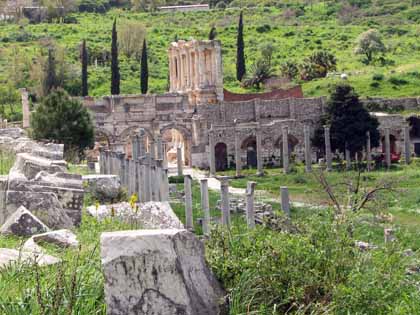
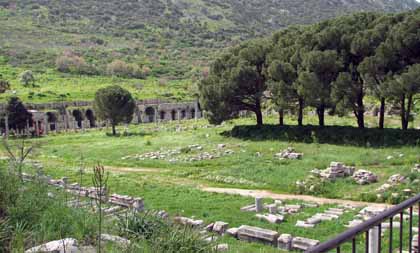
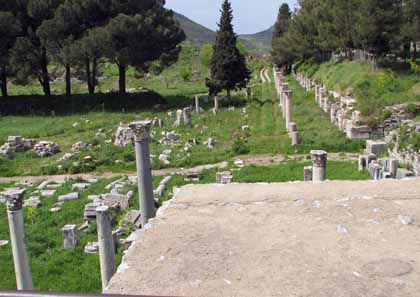
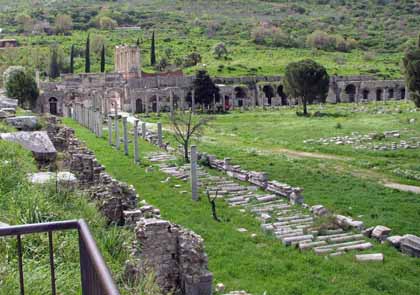
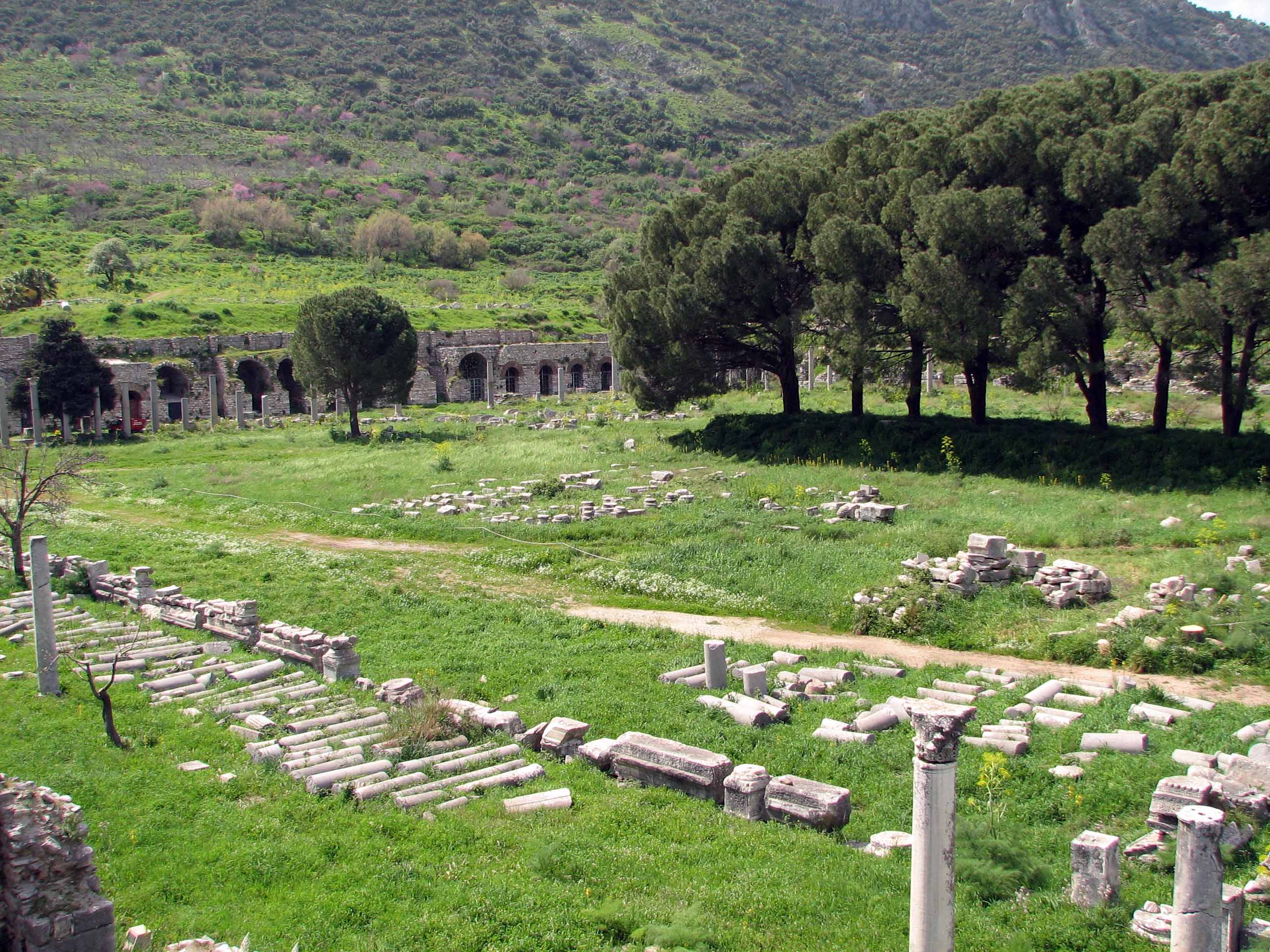
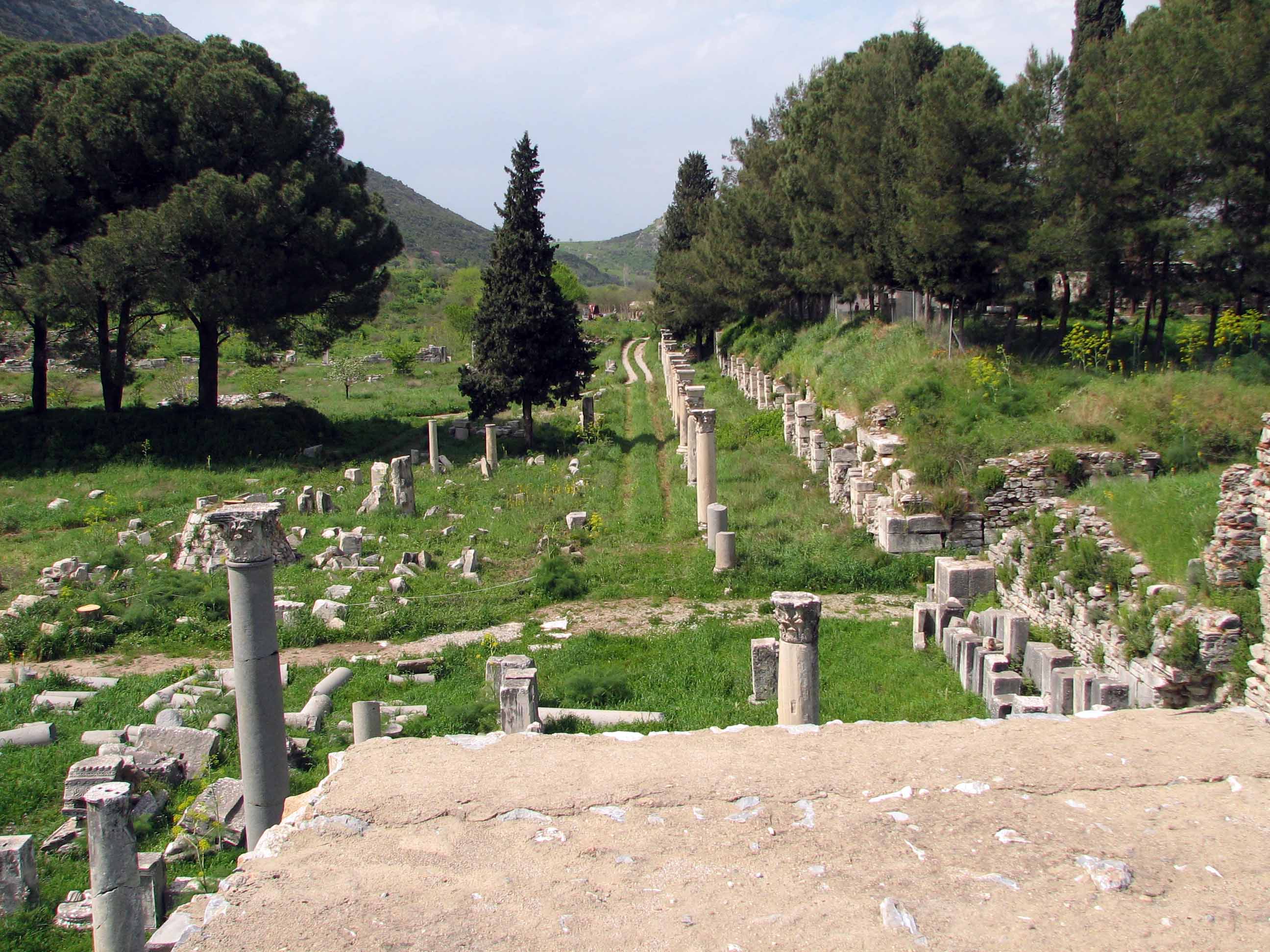
This agora temple (right - above and below - center) was built for the Egyptian merchants. It was located on the Commercial Agora near the western gate. There is also another entrance into the temple from the south-west corner of the Agora through stairs.
There are certain indications that suggest the temple was never finished fully. It is estimated that the construction of the temple was started in the 2nd century A.D.
There is a statue found inside the temple made by using the Egyptian granite. Also some inscriptions found inside the temple indicate that the temple was constructed for those who believe in Serapis. In Ephesus Museum there is a monument on which the main Goddess of Ephesians, Artemis, and the principal god of Egypt, Serapis, take place together with garland as a symbol of peace.
It is well documented fact that Ephesus had a very strong commercial link with the influential port city of Egypt, Alexandria. During these ancient times Egypt was the biggest producer of wheat. They exchanged wheat with other commercial items from Ephesus and other Ionian cities.

It is the road starting from the great theatre to the Celsus Library, which is the portion of the sacred way that leads past Panayirdagi to the Temple of Artemis. The construction of the marble road dates to the 1st century A.D, and it was rebuilt in the 5th century. The western side of the road is enclosed by the agora wall, and on the wall is a higher platform, which was constructed during the reign of Nero. It was built over the wall, for pedestrians.
The busts and statues of the important people were erected along the road, and the letters from emperors were carved into the marble blocks to let people read.
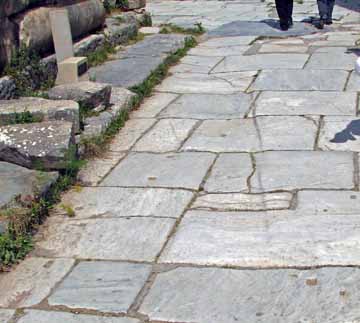
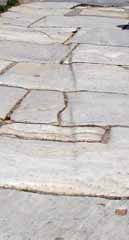
Chariot grooves
A really neat thing on this road to and from the Great Theater is the grooves cut in the marble road. These groves are the result of the passage of innumerable chariots up and down this road.
The Great Theater
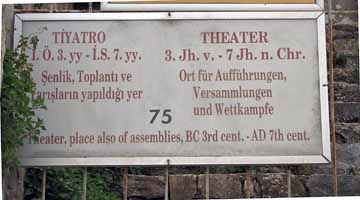

Construction of the Great Theater of Ephesus may have begun during Hellenistic times: Lysimachus (d.281 BC) is traditionally credited with building the theater, but so far there is no archaeological evidence for its existence before 100 BC. However, Lysimachus may have chosen the building site and begun the preparation of the site, a process that required 60 years of digging in the mountainside.
A small Hellenistic theater was probably built here around 200 BC, but the theater seen today dates almost exclusively from Roman times. Constructed primarily in the 1st century (beginning about 40 AD), it was expanded periodically and used continously until the 5th century.
Earthquakes damaged the theater in the 4th century, after which it was only partially repaired. By the 8th century, the theater was incorporated into the city defense system.
Today, the theater is restored and is put to use every May during the Selçuk Ephesus Festival of Culture and Art.
In the 1st century AD, the Apostle Paul spent over three years in Ephesus preaching the Gospel. According to tradition, he delivered a sermon condemning pagan worship in this theater.
And according to the Acts of the Apostles (19:23-41), the theater was the site of the "riot of the silversmiths" in which those who made silver figures of Artemis rioted because Paul's preaching was bad for business:
"Soon the whole city was in an uproar. The people seized Gaius and Aristarchus, Paul's traveling companions from Macedonia, and rushed as one man into the theater. Paul wanted to appear before the crowd, but the disciples would not let him. Even some of the officials of the province, friends of Paul, sent him a message begging him not to venture into the theater. The assembly was in confusion: Some were shouting one thing, some another. Most of the people did not even know why they were there.... (Acts 19:29-31)"
Built into the northern base of Panayirdag (Mt. Pion), the theater rises 30m (100 feet) high and can seat 25,000 people. There are magnificent views to be had from the top. Most of the marble paving and some lower elements of the backdrop remain on the stage.
The Apostle Paul was active in Ephesus from the autumn of 52 to the spring of 55, after his missionary work in Macedonia, Corinth and Achaia. In a paper written for the 1994 Harvard symposium on Ephesus. Helmut Koester has provided a very useful summary of Paul’s activities in Ephesus based on current biblical scholarship; the following brief account draws heavily on Koester’s work.
Despite his important role there, it seems unlikely Paul was the first Christian missionary in Ephesus. The Gospel of Luke records that Paul sailed with Priscilla and Aquila from Corinth to Ephesus then left them there and sailed for Syria (Acts 18:20-21). This technically makes Paul the first preacher in Ephesus, but many commentators regard it as an insertion to that end by Luke. In reality, Paul probably did not stop in Ephesus at all before the arrival of Priscilla, Aquila and also Apollos. So when Paul arrived in Ephesus in the autumn of 52, a Christian community had already been founded under the leadership of these missionaries.
Over the next two years and three months, Paul had an eventful stay in Ephesus. He struggled against opposition, was imprisoned at least once, feared for his life, and wrote the bulk of his correspondence (1 Corinthians, most of 2 Corinthians, Philippians, Galatians and Philemon.
In 1 Corinthians, Paul indicates that he was staying in the city for a prolonged period because ‘a great and effectual opportunity has opened to me and there are many adversaries’ (16:9). Paul also comments that he ‘fought with wild beasts in Ephesus’ (15:32), a statement that has been interpreted in a variety of ways. While a later tradition developed a story of Paul’s literal battle with wild beasts in Ephesus’ stadium it is more likely a metaphor for conflict with human opponents or perhaps within himself. Still, in a letter written from Macedonia in the summer of 55, after Paul had left Ephesus Paul indicates he had been in serious danger. He writes:
"We do not want you to be uninformed, brothers, about the hardships we suffered in the province of Asia. We were under great pressure, far beyond our ability to endure, so that we despaired even of life. Indeed, in our hearts we felt the sentence of death. But this happened that we might not rely on ourselves but on God, who raises the dead. He has delivered us from such a deadly peril, and he will deliver us. (2 Cor 1:8-10)"
This strongly indicates that Paul was imprisoned in Ephesus, probably in the winter of 54/55. Many scholars now believe that it was during this imprisonment, rather than one in Rome, that Paul wrote Philippians and Philemon. If so, these two letters thus provide more information about the situation in Ephesus in the early 50s AD. In Philippians, Paul indicates that the palace guard and everyone else knows he is imprisoned for his faith in Christ and that his imprisonment have encouraged ‘most of the brothers’ to spread the Gospel more courageously (1:13-14). This provides interesting supplementary information to the ‘adversaries’ (1 Cor 16:9) and ‘wild beasts in Ephesus’ (1 Cor 15:32) he mentioned in an earlier letter. Philippians also provides a record of his struggle with the real possibility of death that he later recalled in 2 Cor 1:8-10, in which he hopes to act courageously whatever happens and remarks that ‘to live is Christ and to die is gain’ (1:21).
The most famous account of Paul’s opposition in Ephesus comes from the Book of Acts, with the riot of the silversmiths following a sermon Paul gave against polytheism in the Great Theater. Although the author of Acts appears to have been personally familiar with Ephesus and to have used earlier sources for his account, he also freely adapted and embellished his sources to fit with the themes of his composition. In addition, the book was written in approximately 100 AD and most likely reflects the situation in Luke’s time more than that in Paul's. But the account in Acts 20:14-17 is thought to be based on historical sources and indicates that Paul did not dare return to Ephesus after his departure.
The clear picture of Paul’s activities in Ephesus, then, is one of frequent and sometimes violent opposition. Although enough converts were made to form a small Christian community, it seems there was a strong pagan resistance to the Christian message of Paul.

The main gate to the theater
The large stadium or hippodrome of Ephesus was originally built in the 3rd century BC and continued to be used, for slightly different purposes, even after the rise of Christianity.
The stadium has been dated by an inscription to the reign of Nero (54-68 AD). But the Roman stadium probably replaced an earlier structure built during the rule of Hellenistic king Lysimachus (3rd century BC).
Ephesus' stadium was well-maintained over the centuries and even received a major rebuilding in the 4th century. Gladiatorial and animal combats fell out of favor with the rise of Christianity, but athletic games continued here well into the Byzantine period.
When Ephesus was mostly abandoned in the 7th century, much of the stadium was dismantled and its stone added to the fortifications on Ayasuluk hill.
The stadium was shaped like a long 'U' and measured 229m by 28m. The spectactors' seats on the south side were cut from the side of Mt. Pion, while those on the north side rested on vaults.
The stadium narrowed in the center, allowing the eastern section to be turned into an arena for the more gory spectacles of gladiators and animal combats. Wild animals were kept in small rooms nearby.
The principal entrance to the stadium was through a well-preserved monumental gate on the west side.

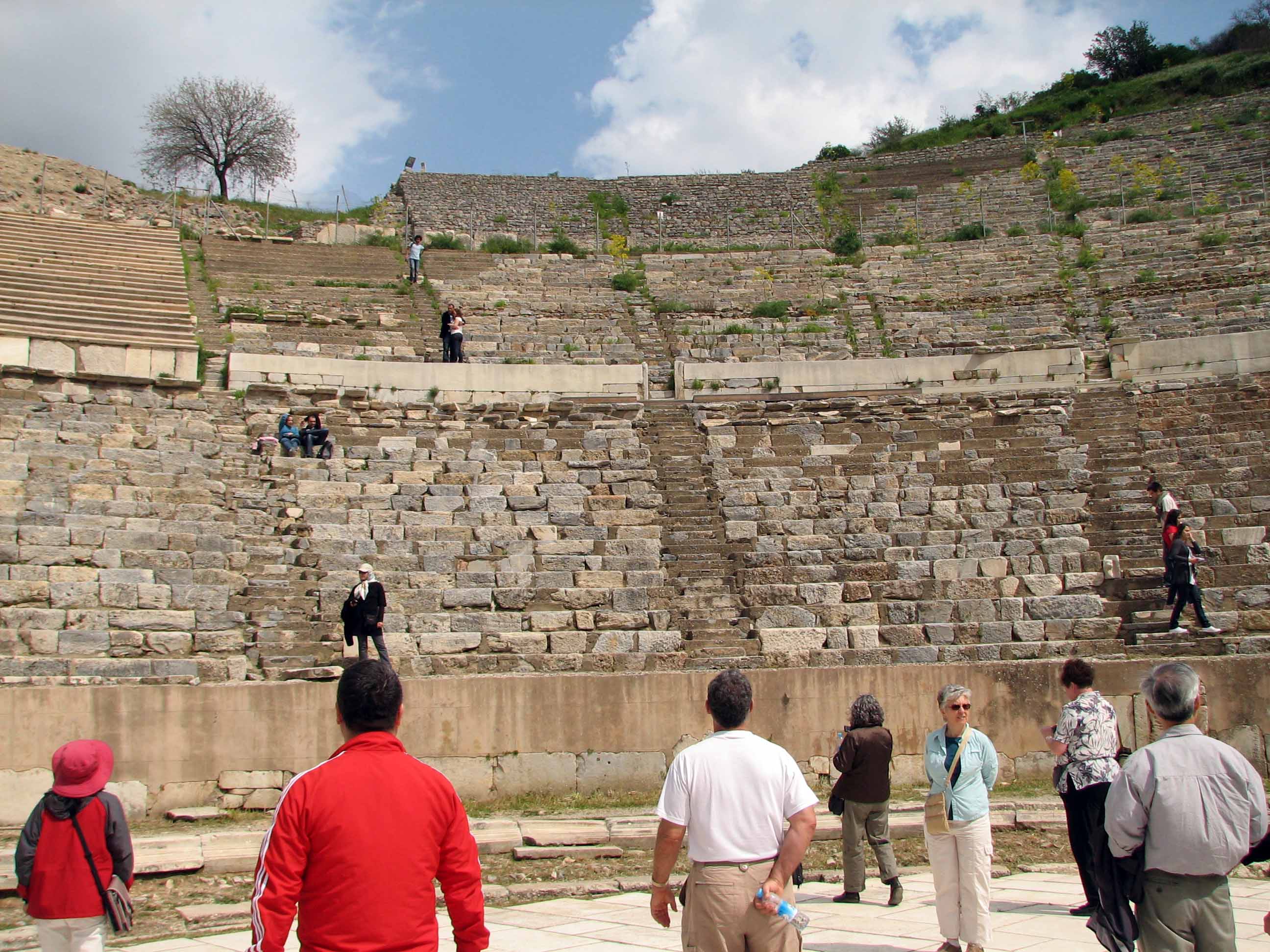
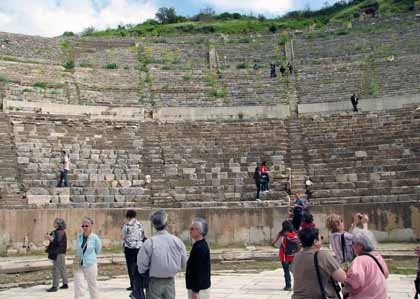

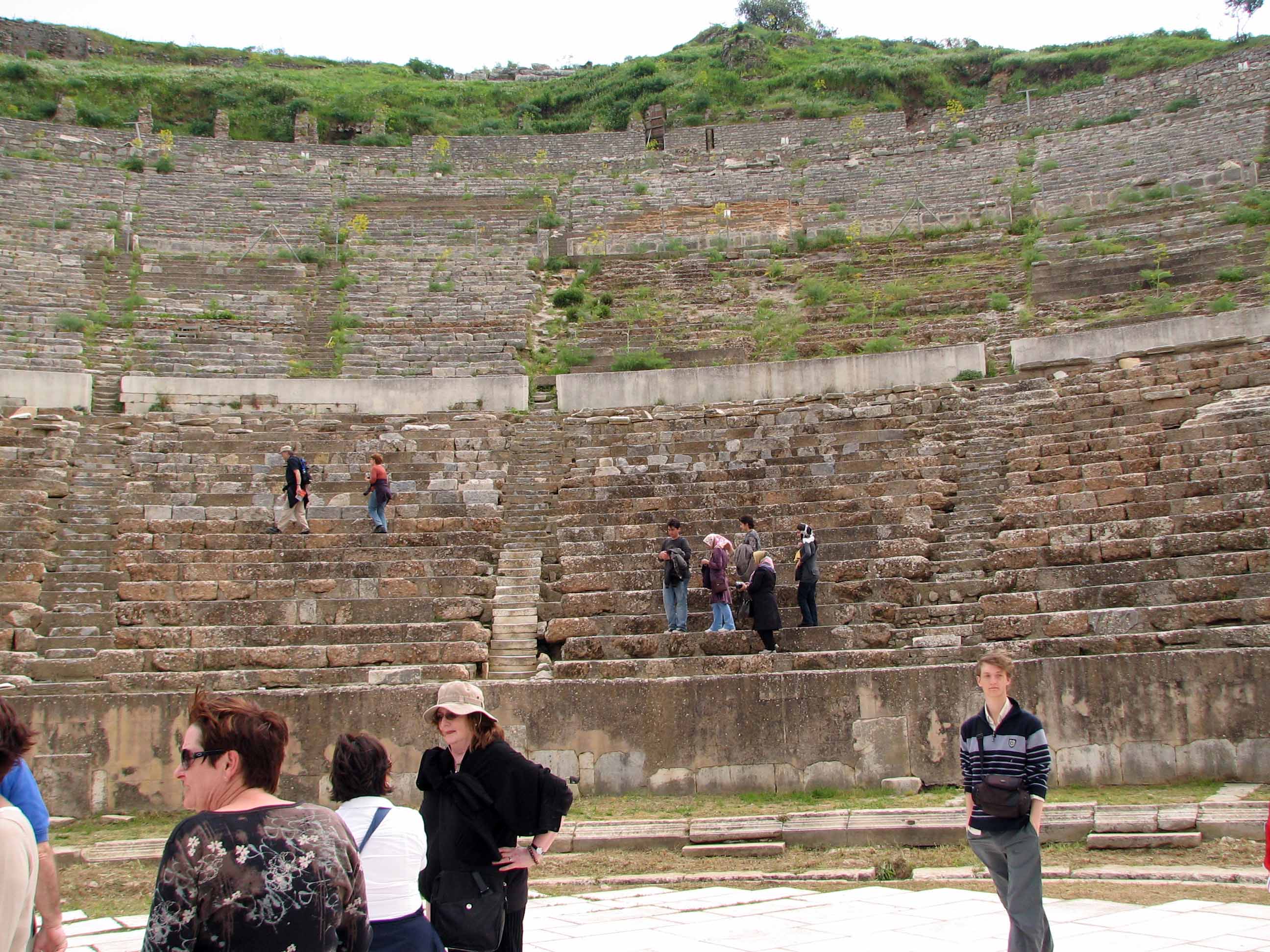
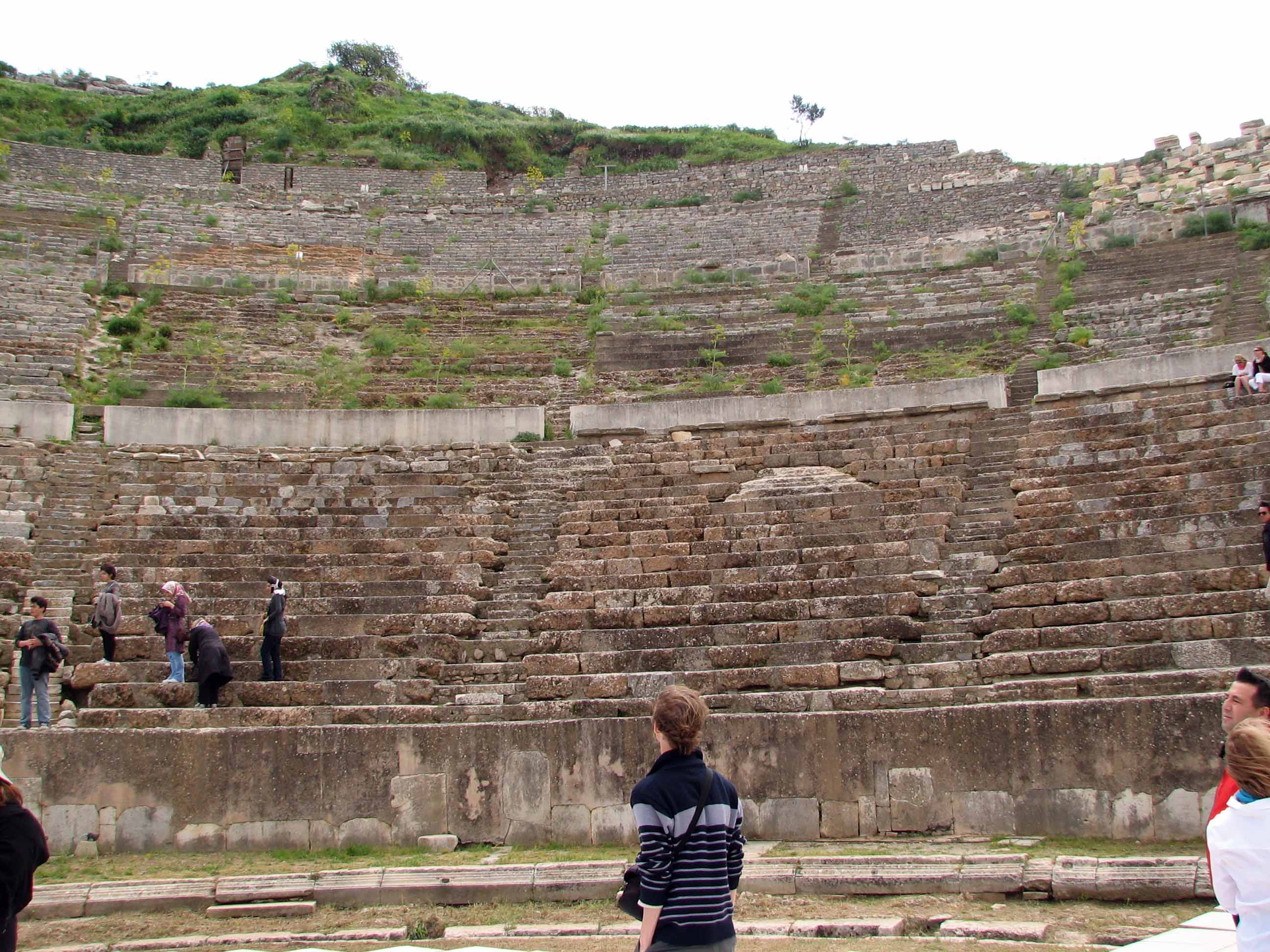
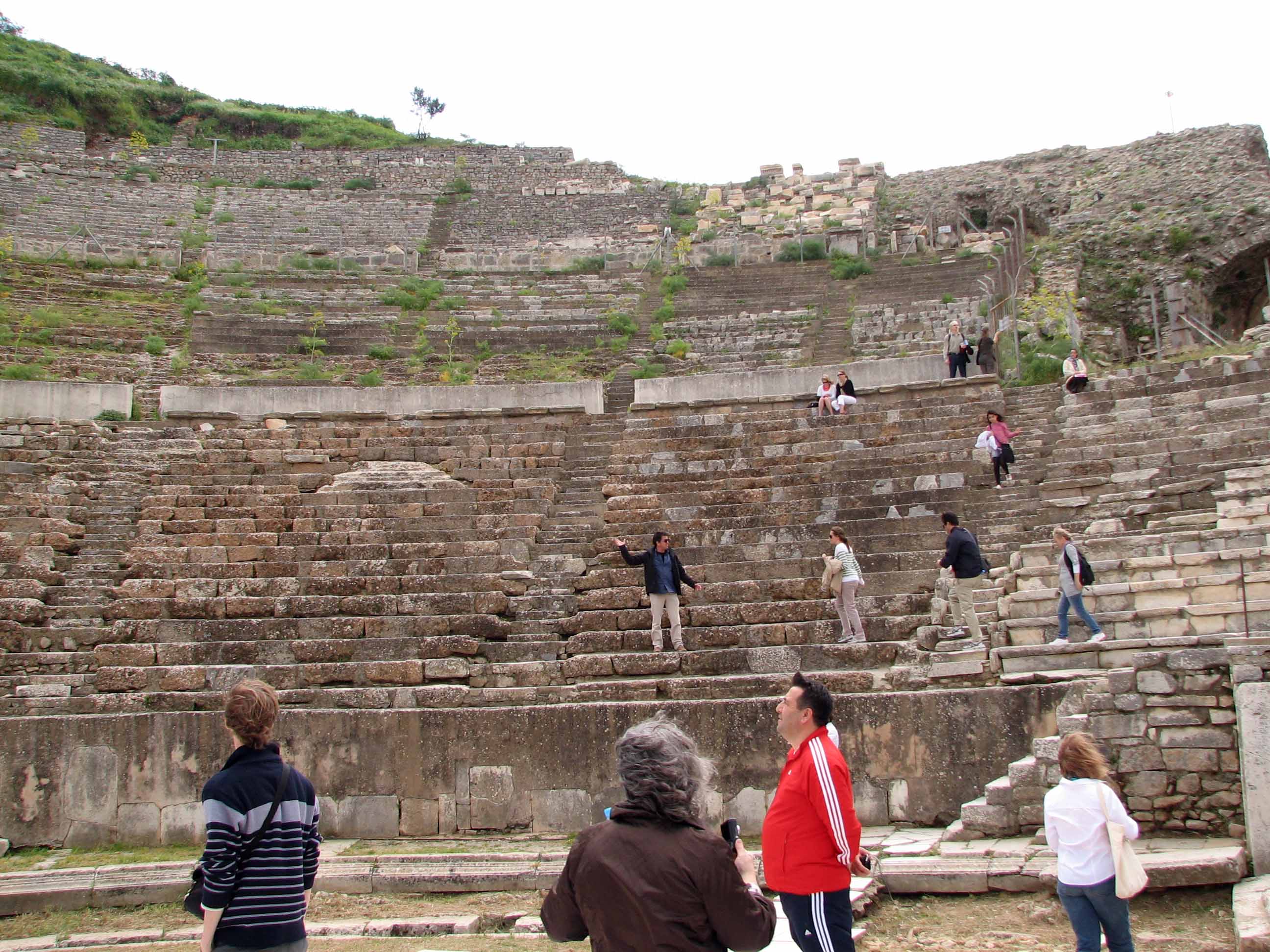
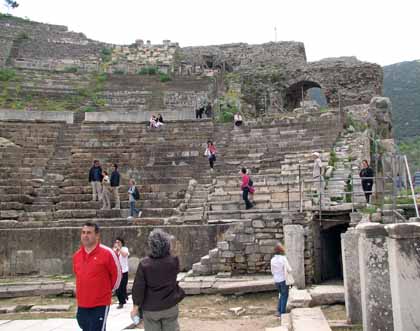
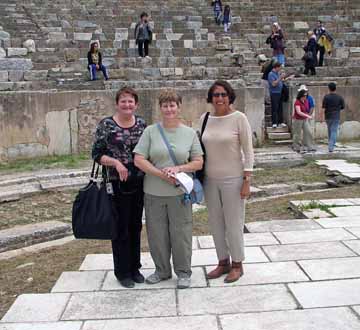
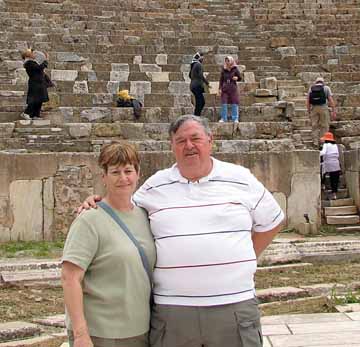
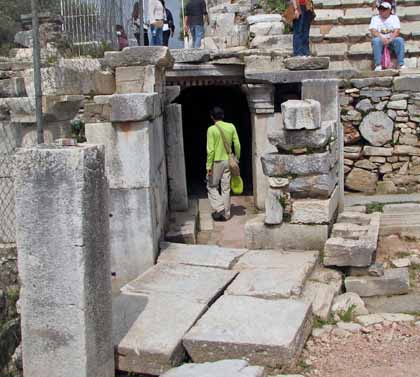
As seen above and in the pictures that follow, behind and beneath the stage were narrow, dark tunnels and rooms for both gladiators and wild animals.
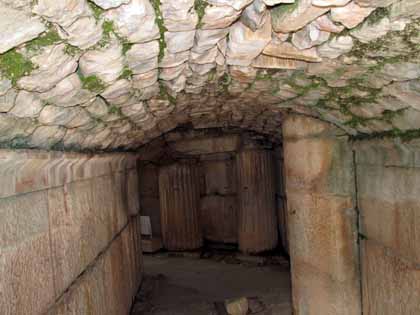
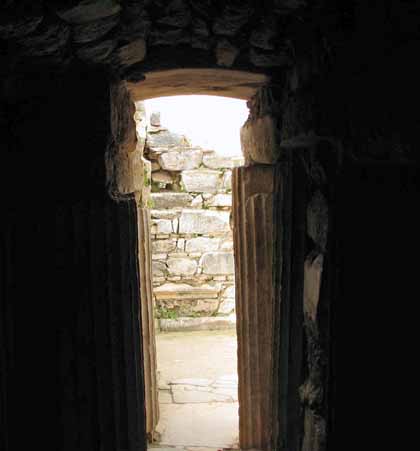
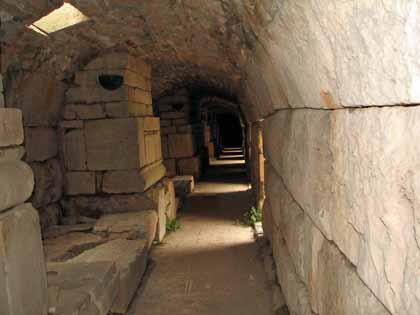
As we leave the Great heater we see additional stele - his one carved in stone which has not been uniformly finished as a flat surface prior to carving.
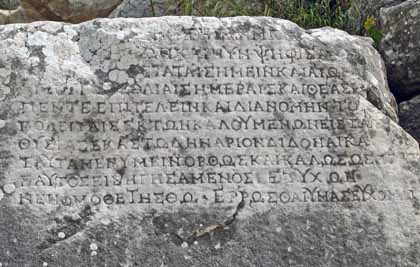
Harbor Street
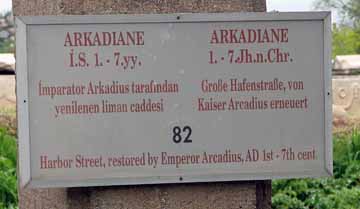
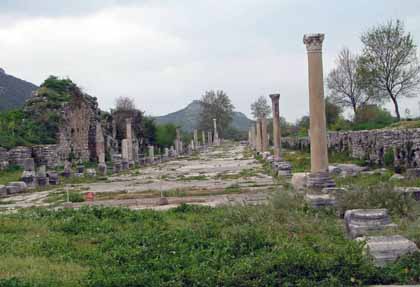
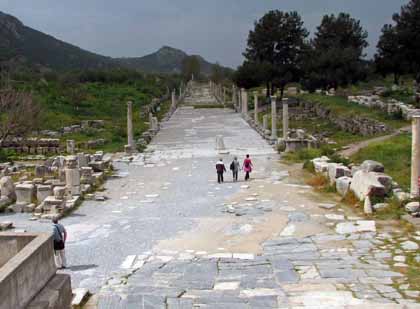
This street through the agoras led directly to the harbor - which was quite close during the time of Ephesus' height as a trading center.
These pictures below were provided because we took a well deserved break. I think there were another couple pictures taken at the same time and they may have been much better. I'm uncertain the entire group is in these, but, as you see, our guide was busy giving us information.
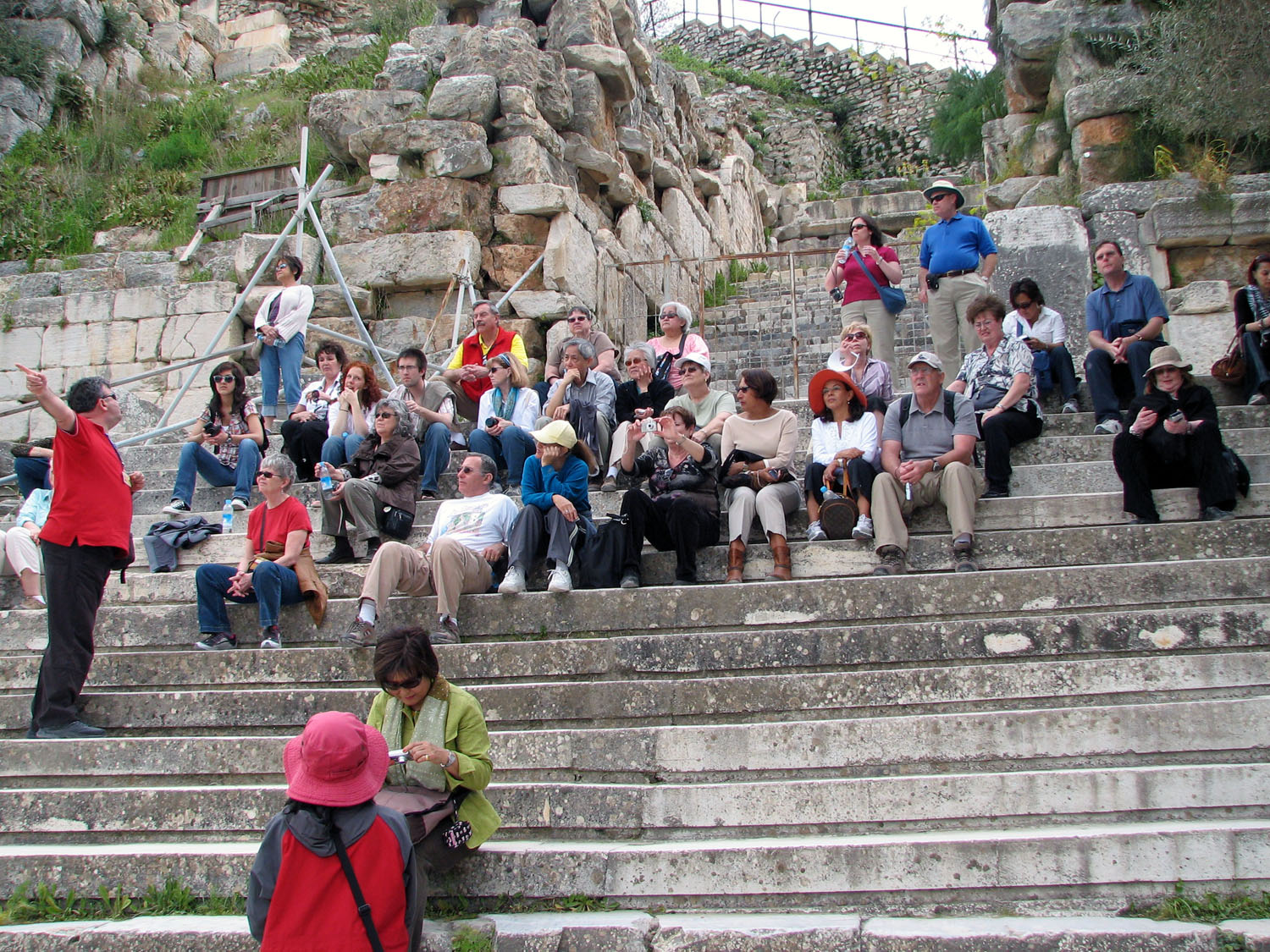

Larger, clearer group pictures, inside, are found in the Fellow Travelers page.
Looking back on the Theater
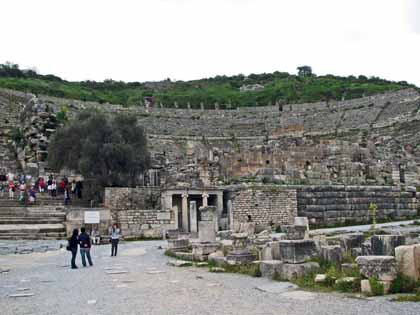
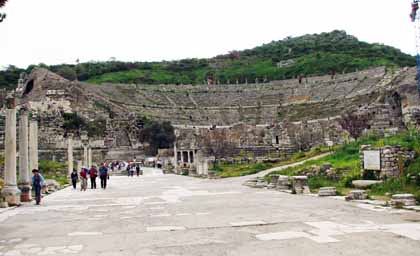
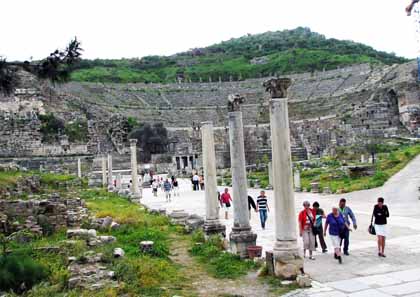
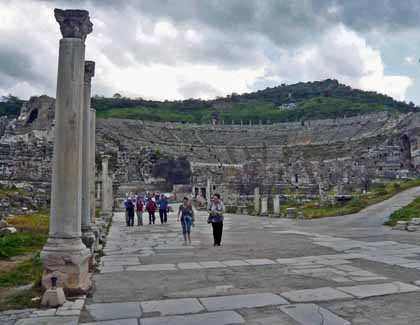


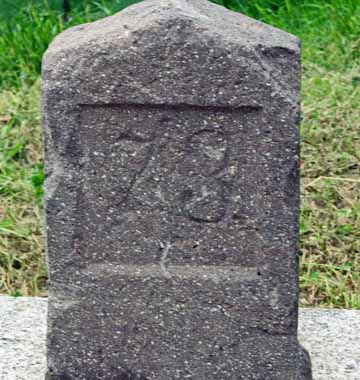
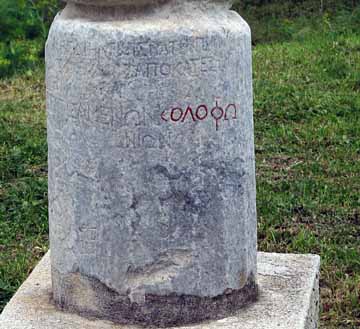
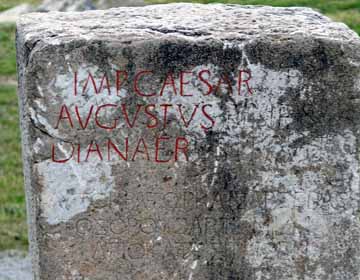
~ ~ ~ ~ ~ ~ ~ ~~ ~ ~ ~ ~ ~ ~ ~ ~ ~ ~ ~ ~ ~ ~ ~ ~ ~ ~
This is the site of the ancient city acropolis. In the course of time it assumed the form of an alternative settlement and, after the silting up of the harbours had reduced the importance of Ephesus as a port, the Byzantines built a castle on Ayasoluk Tepesi. After its capture by the Seljuks in the 11th century the hill changed hands several times between the Byzantines and the Anatolian Seljuks, finally emerging in 1438 as a commercial centre subject to the Aydinogullan. It was finally incorporated into Ottoman territory in 1402. It came under Greek occupation in the years 1919 to 1922. Since 1957 it has formed part of the province of Izmir.
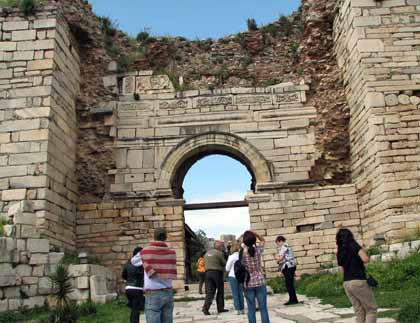
The Main Gate and entrance to St. John's Basilica

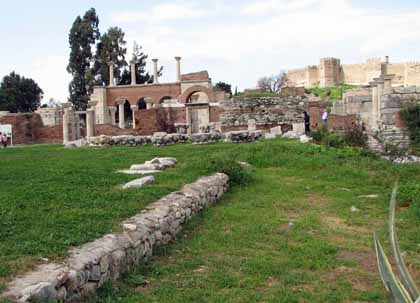
Basilica of St. John in background.
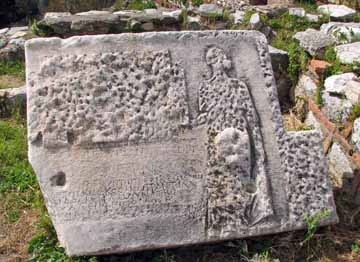
As seen particularly in Egypt, the "old fashioned" method of erasing information and pictures - a chisel.
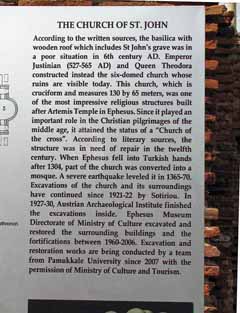

The Basilica of St. John (St. Jean Aniti) was a great church in Ephesus constructed by Emperor Justinian in the 6th century. It stands over the believed burial site of St. John, who is identified as the apostle, evangelist (author of the Fourth Gospel) and prophet (author of Revelation).
The basilica is on the slopes of Ayasoluk Hill near the center of Selçuk, just below the fortress and about 3.5 km (2 miles) from Ephesus.
There was a St. John identified with Ephesus since as early as the 1st century, who seems to have originally been the author of Revelation who was exiled on Patmos. By the second century this John was equated with John the Evangelist, author of the Gospel of John (presumed also to be the same person as John the Apostle, beloved disciple of Jesus).
Legend had it that John wrote his gospel in Ephesus at the request of other disciples, then died in the church named for him on Ayasoluk Hill. Later legends developed that he was not really dead, but sleeping, and dust could even be seen moving above his grave as he breathed.
The 13th-century Golden Legend narrates John's death as follows:
According to Isidore, when John was 98 years old, that is, in the 67th year after the Lord's passion, the Lord appeared to him with his disciples and said: 'Come to me, my beloved:it is time for you to feast at my table with your brothers!' John rose and was about to go, when the Lord added: 'You will come to me on Sunday.'
When Sunday arrived, all the people gathered in the church that had been built in his name, and John preached to them at cockcrow, exhorting them to be steadfast in the faith, and zealous in carrying out the commandments of God. Then he had them dig a square grave near the altar and throw the earth outside the church.
He went down into the grave and, with arms outstretched to God, said: 'Lord Jesus Christ, you have called me to your feast: here I am, and I thank you for deigning to invite me to your table. You know that I have longed for you with all my heart!' When he had said this, he was surrounded by a light so brilliant that he was lost to human sight. Then, when the light faded, the grave was found to be full of manna. This manna is still produced there to this day, and it covers the floor of the grave, looking rather like the fine grains of sand at the bottom of a spring...History
St. John's grave was marked by a memorial and enclosed by a church of modest proportions in the 4th century. In the 6th century, Emperor Justinian (527-65 AD) believed that a tomb dating from the 300s was John's, so he built a magnificent church on the site dedicated to the saint.
The traditional tomb of St. John, located under the main central dome, elevated the site to one of the most sacred sites in the Middle Ages and thousands made pilgrimage here.
But with the decline in importance of Ephesus and after Arab raids, the basilica fell into ruins until the Seljuk Aydinoglu clan converted it into a mosque in 1330. The building was then completely destroyed in 1402 by Tamerlane's Mongol army.
The ruined church was thereafter pillaged for building materials, but recent restoration enables visitors to understand its size and visualize its former splendor.
St. John's basilica was cruciform and roofed with six massive domes. The capitals facing the nave (central aisle) bear the monograms of the Emperor Justinian and his wife Theodora.
The current entrance leads into the basilica through the southern transept. Originally, entry was through the oversize exterior courtyard atrium to the west of the nave, which led worshipers through the narthex and finally into the far end of the nave.
The brick foundations and marble walls have been partially reconstructed; if they were fully restored, the cathedral would be the seventh largest in the world.
More recent excavations east of the apse have revealed a baptistery and central pool, along with an attached chapel covered in frescoes depicting the saints.
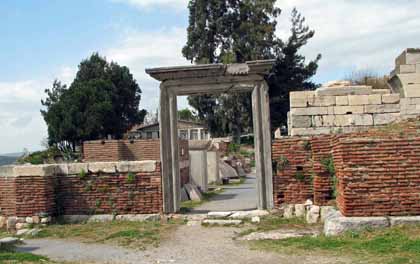
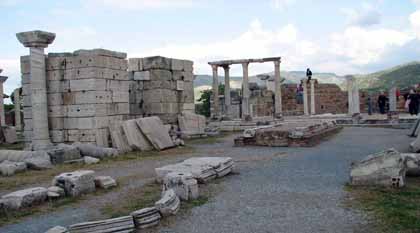


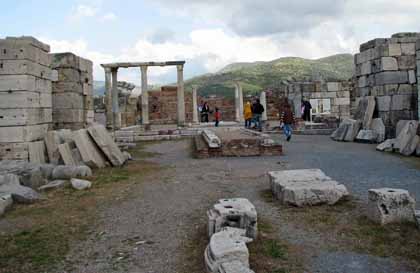
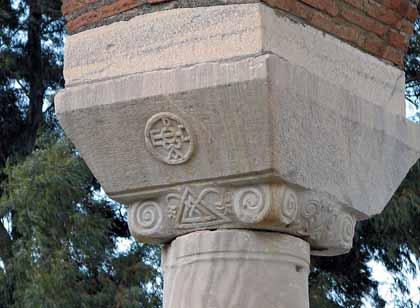 I've
forgotten what this mark signifies. Hakan told us innumerable times - and I've
simply forgotten. I recall only that it is the initials of the man and
woman who did the primary building here and they wanted to make certain that
anyone who came here would know their contribution.
I've
forgotten what this mark signifies. Hakan told us innumerable times - and I've
simply forgotten. I recall only that it is the initials of the man and
woman who did the primary building here and they wanted to make certain that
anyone who came here would know their contribution.

Following the visit by the Pope
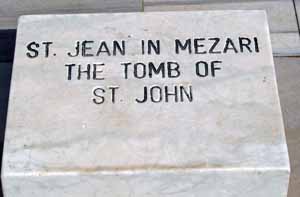
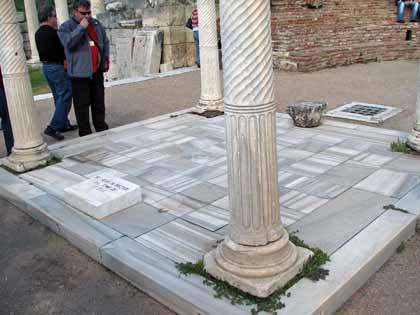
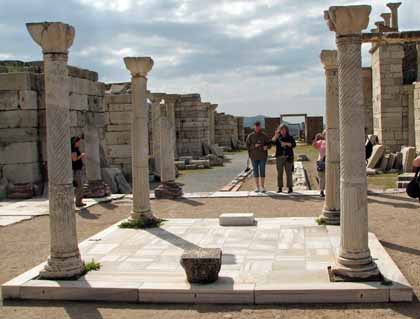

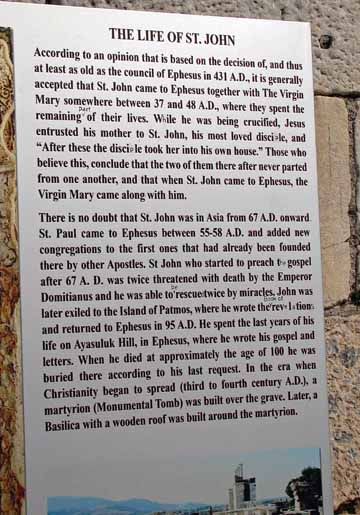
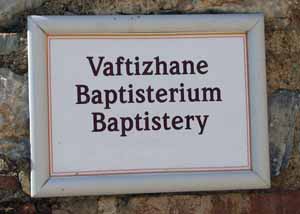
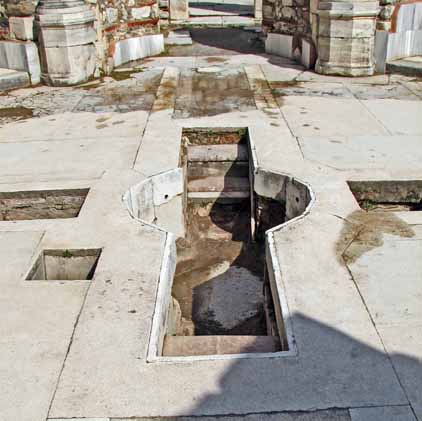

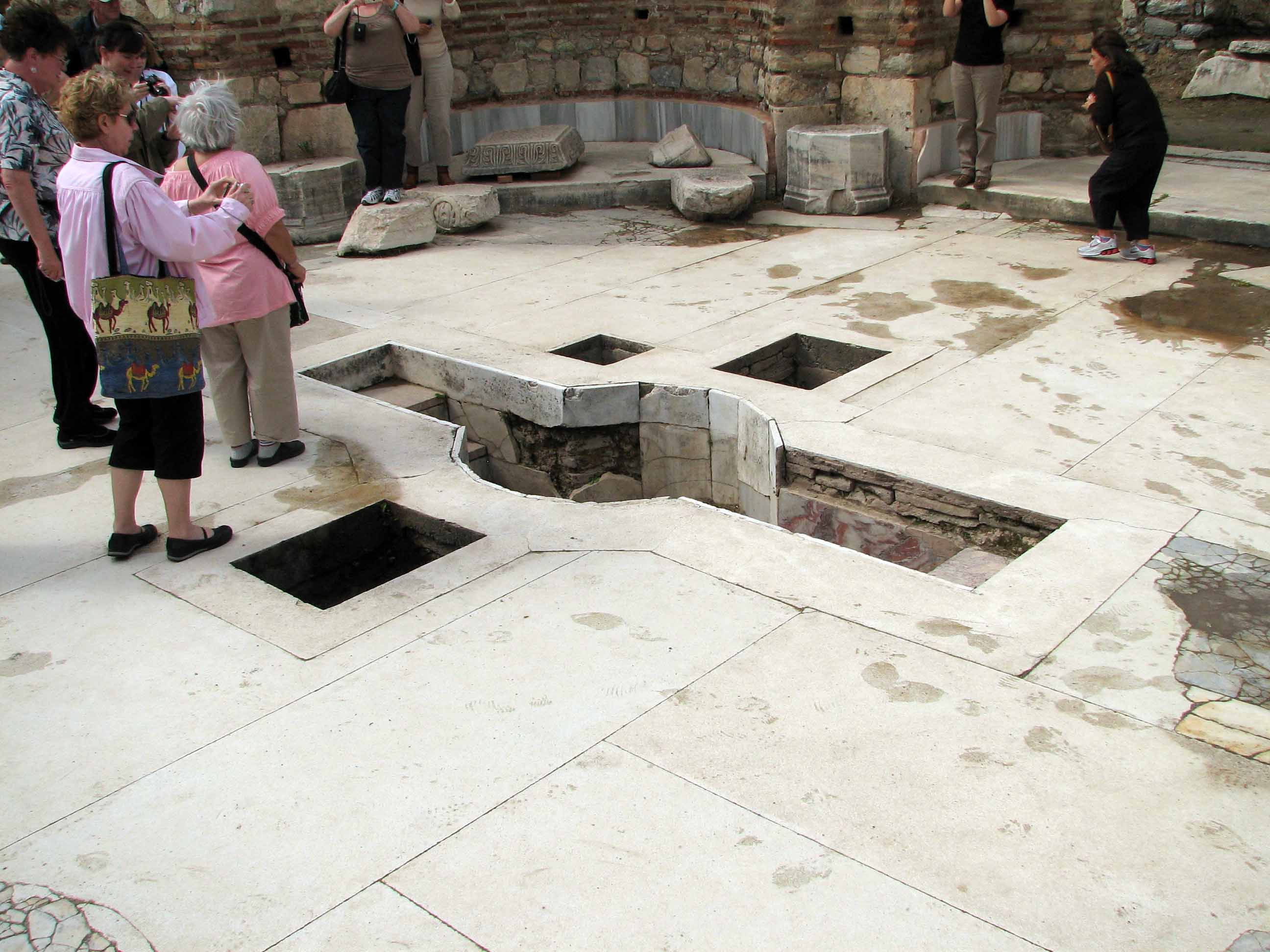
Different views and attractions while walking around the Basilica Grounds
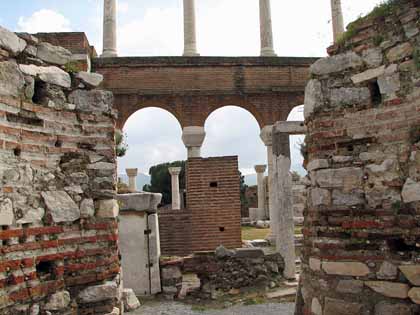

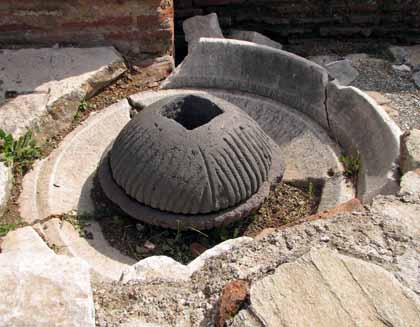 No
- I do not recall what this was. It may have been part a grinding stone
and base.
No
- I do not recall what this was. It may have been part a grinding stone
and base.

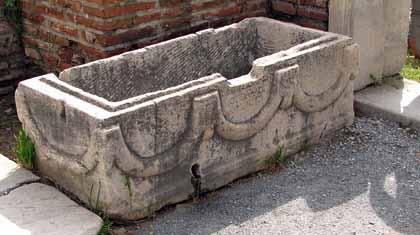
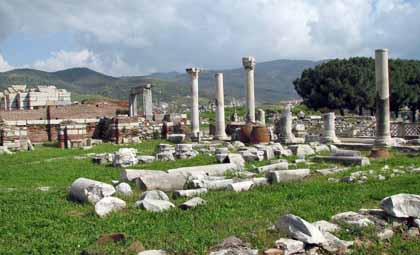
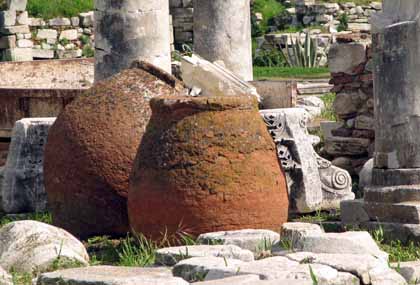
Large clay storage pots caught my eye.
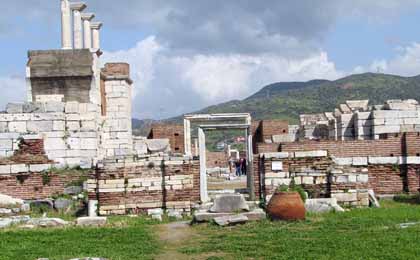
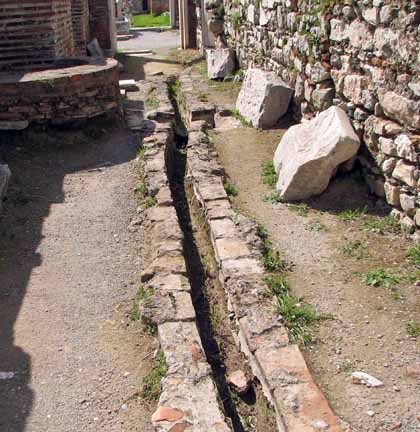
There was a water system on the Basilica grounds
- now whether this was for water in or drainage out - I don't know.
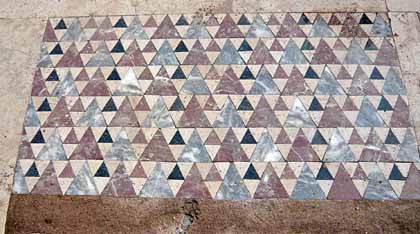
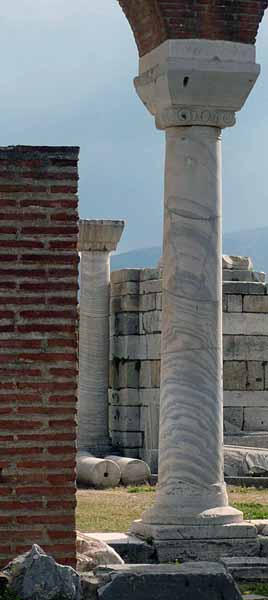

The grounds have great mosaics - made of stone so they won't fade. They are pretty much as found - I didn't see a lot of reconstruction of the mosaics.
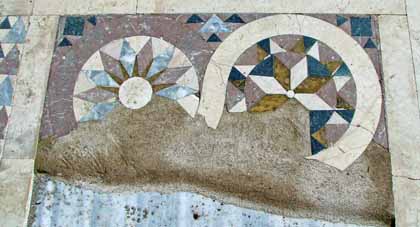
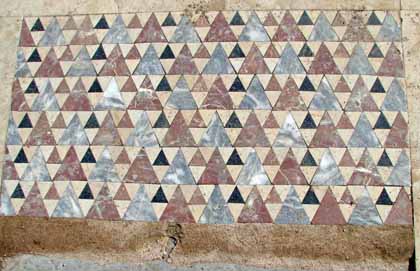
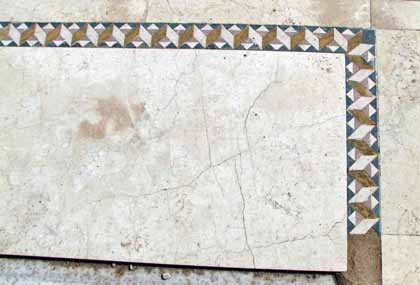
 And yes -
even on the Basilica grounds - a game carved into the street stones.
And yes -
even on the Basilica grounds - a game carved into the street stones.
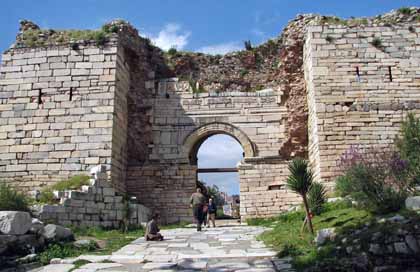
And we leave the Basilica.
~ ~ ~ ~ ~ ~ ~ ~ ~ ~ ~ ~ ~ ~ ~ ~ ~ ~ ~ ~ ~ ~ ~ ~ ~ ~ ~ ~ ~ ~ ~
Isabey Mosque

The Isabey Mosque in Selçuk (near Ephesus) is a beautiful example of Seljuk Turkish architecture in an atmospheric location. It is the oldest known example of a Turkish mosque with a courtyard.
The Isabey Mosque was built in 1375 at the direction of the Emir of Aydin. Columns and stones from the ruins of the city of Ephesus and the Temple of Artemis incorporated into the building. The mosque was restored in 1934.
The mosque is located just beneath the citadel in Selçuk near the Basilica of St. John. It measures 51m (153 feet) by 57m (171 feet) including a large courtyard.
The mosque itself consists of two lateral aisles covered with two domes in the center. The surviving brick minaret on the north side has an octagonal base. The west facade is covered in marble, carved with beautiful geometric designs and calligraphy inscriptions.
Inside are a mihrab and pulpit, both made of marble, and painted turquoise tiles in the domes. The columns of the interior are Classical, from the local ruins.
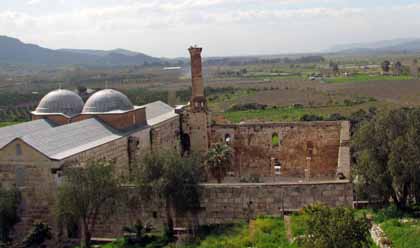

A stork's nest on the top of the column at the Isabey Mosque
~ ~ ~ ~ ~ ~ ~ ~ ~ ~ ~ ~ ~ ~ ~ ~ ~ ~ ~ ~ ~ ~ ~ ~ ~ ~ ~ ~ ~ ~ ~ ~
Ayasuluk Castle
Ayasuluk Castle, or the Citadel of Ayasuluk, is atop Ayasuluk Hill in Selçuk, Turkey, in the foothills of the Aydin mountains. As you've seen, I can't pass a fortress without multiple pictures.
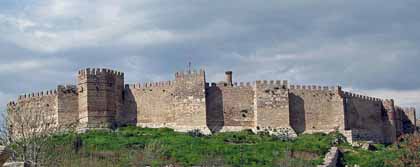
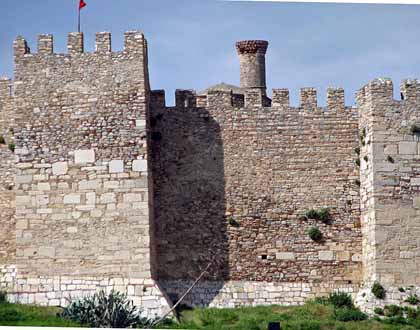

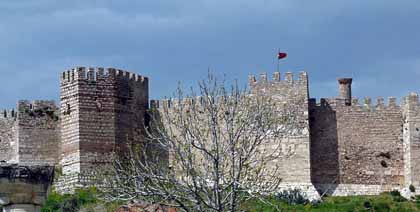

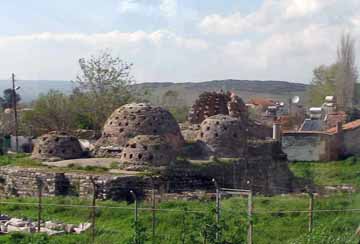
~ ~ ~ ~ ~ ~ ~ ~ ~ ~ ~ ~ ~ ~ ~ ~ ~ ~ ~ ~ ~ ~ ~ ~ ~ ~ ~ ~ ~ ~ ~ ~ ~ ~
The Temple of Artemis
(pictures above from Wikipedia - the free encyclopedia)
The Temple of Artemis (Artemision) A column and scanty fragments strewn on the ground are all that remains of the Seventh Wonder of the World. According to Strabo, the Temple of Artemis was destroyed at least seven times and rebuilt just as many times. Archaeological findings instead attest to at least four rebuilding of this temple, starting in the 7th century B.C. . Chersiphone and Metagene erected an Ionic dipteral temple in the 6th century B.C. and its building required was set on fire by Herostratus; the successive majestic structure, built entirely of marble, was begun in 334 and was finished in 250 B.C. It aroused the admiration of even Alexander the Great who would have liked to have taken charge - at his own expense - of the continuation of the work. Among others, Scopas and Praxiteles worked there, while the design is attributed to Chirocratus. Today one can only see the ruins of the foundations of this marvelous construction of the Hellenistic Age, entirely made of marble and full of sculptured columns' capitals and shafts. The most beautiful remaining of this temple are today exhibited in the London British Museum.

The Greek goddess Artemis and the great Anatolian goddess Kyeble were identified together as Artemis of Ephesus.
The many-breasted "Lady of Ephesus", identified with Artemis, was venerated in the Temple of Artemis, one of the Seven wonders of the world

The Temple of Artemis, once one of the Seven Wonders of the World, is represented only by one inconspicuous column, left by an archaeological excavation by the British Museum in the 1870s.
As our guide said, "We refer to the Temple of Artemis as the 'Hole in the Ground', as that was all that was left when the British Museum left."
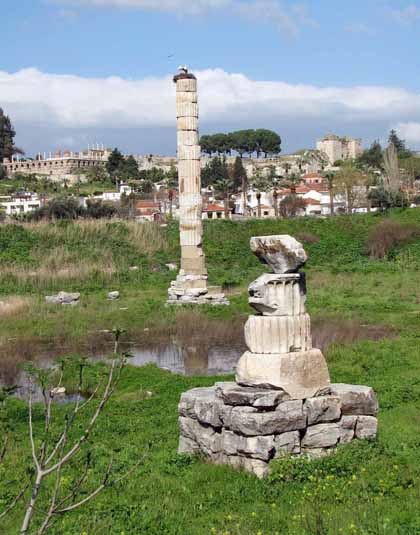
As you see, the Hole in the Ground is actually filled with stagnate water and green slime. In the one corner you will see some ducks. One can only speculate what the temple would have looked like if it were preserved, or simply left alone. Thank the British Museum for this loss.
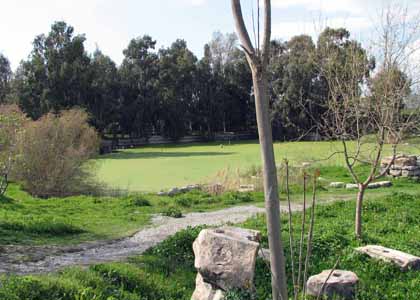
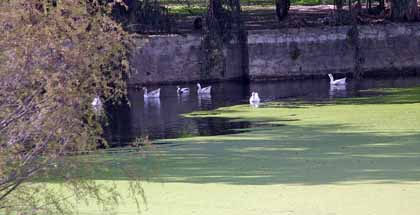
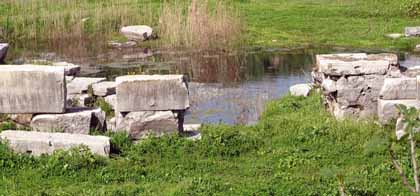
Atop the single column left by the British was a stork's nest. I can't ignore bird pictures - so here we go.....






And we're off to tomorrow's adventures